Living in Asia has its perks; warm weather, friendly locals, old churches, and most of all the best street food in Asia, or maybe even the best street food in the world.
So if you’re traveling across Asia and wondering what best Asian street food you must try; here’s the list of the top Asian food to taste on your travels! With everything from sweet to salty, spicy to sour, and definitely some umami; Asian may just be the best street food in the world!
1. Ice Cream Burrito in Taiwan
By Erica from Travels with Erica
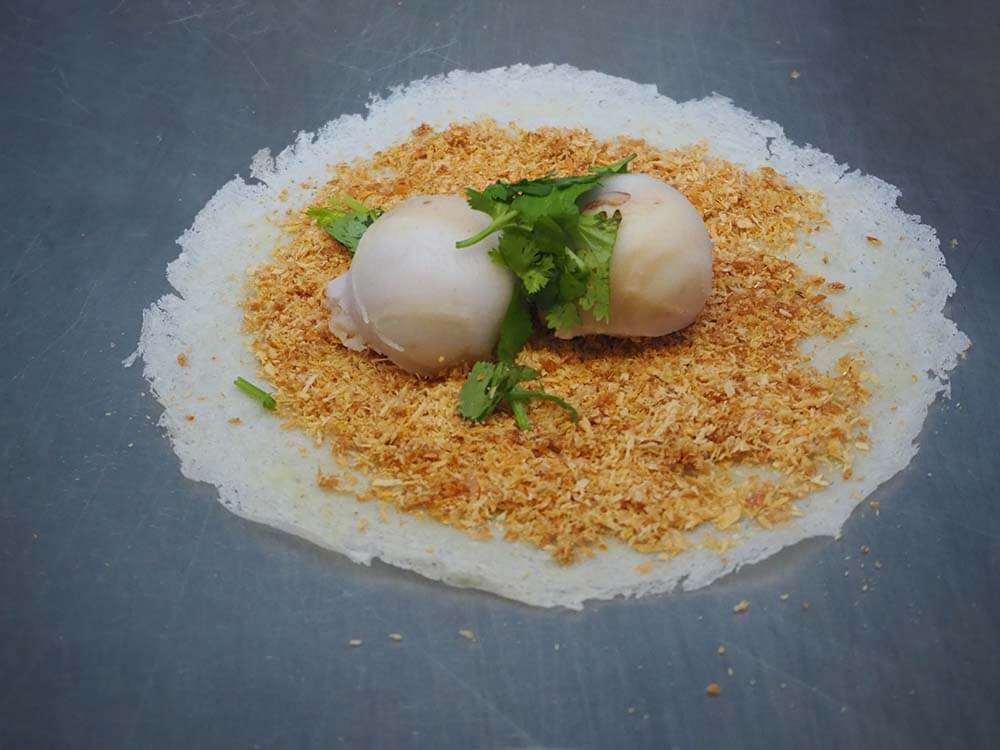
– Pic by Erica from Travels with Erica
Taiwan is known as a foodie’s paradise and indulging in all the different street foods on offer is an essential experience to have while in Taiwan.
One of the more unique offerings is an ice cream burrito. It consists of a flour crepe with two to three scoops of ice cream (normally pineapple or taro flavoured), freshly shaved peanut nugget, and cilantro on top.
The crepe is rolled up like a burrito, placed in a plastic bag, cut in half, and handed over to you to enjoy. It may sound like an odd combination, but it is absolutely delicious and refreshing.
The cilantro can be omitted on request, but the cilantro is the shining star of the dish, so you should try the ice cream burrito with it included. The addition of cilantro makes the dish taste extremely fresh, and the flavour mixes perfectly with the peanut nugget.
Ice cream burritos are sold at most night markets throughout Taiwan, but the most famous is found on Jiufen Old Street just an hour’s bus ride from Taipei. The cost of an ice cream burrito ranges from 35-40 NTD or $1.15-$1.75 USD, so indulging in this delicious treat won’t break the budget!
2. Fishball Noodles in Singapore
By Don from The Money Saving Daddy
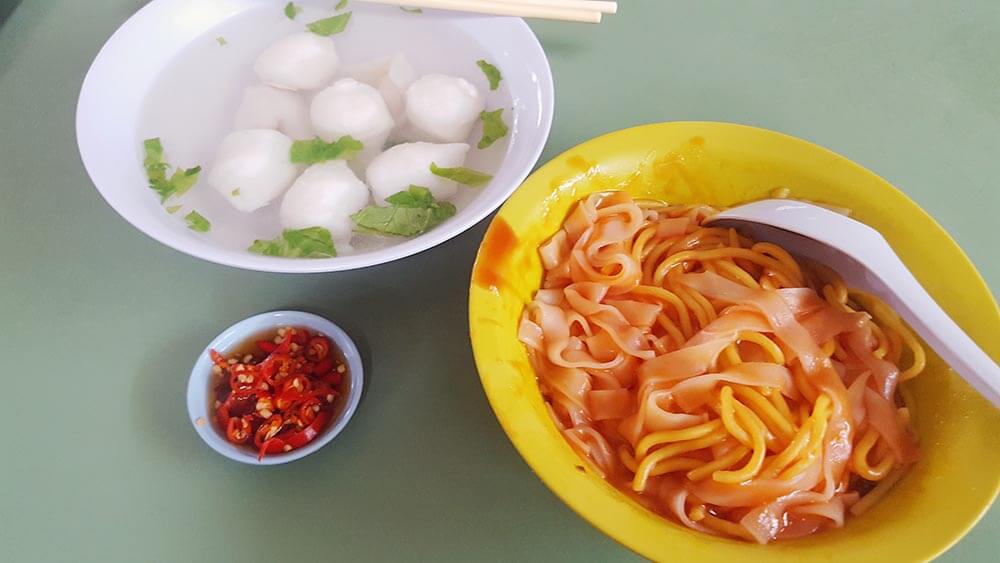
Pic by Don from The Money Saving Daddy
In Singapore, our street food are usually from Hawker centres and coffee shops. And there are plenty of hawker centres and coffee shops in Singapore. And the food is usually very affordable ranging from SGD2 onwards.
And Fishball Noodle is a common yet must try food that you can find in almost all the coffee shops, hawker centres. It is usually sold in dry version (with or without chilli) and the soup version. I normally go for the dry version with chilli, as it also comes with a small bowl of soup.
The fishballs are made from fish paste, into a bite small ball shape. Some will like hand made fishballs, and some will like machine-made fishballs. And they are served with a bowl of noodles, added with sauces like vinegar, ketchup, soy sauce and chilli.
A bowl of fishball noodle will cost from SGD3 in the neighbourhood areas, it will be most costly in an air-conditioned food court from SGD5, still affordable though.
3. Tian Tian Hainanese Chicken Rice in Singapore
By Phil at Gourmet Globe Trotter
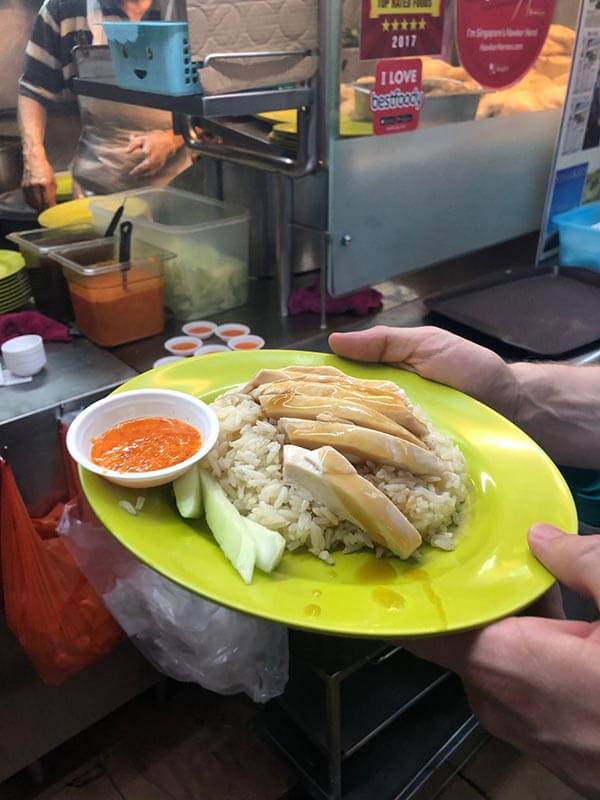
Pic by Phil at Gourmet Globe Trotter
If you watched Crazy Rich Asians, you’ll remember that one of the first things they did after landing in Singapore was visit a hawker center (food courts with a variety of food). It’s here where you’ll not only find cheap eats but Michelin-star stalls with rave reviews from Time Out Magazine and food critics alike.
Tian Tian Hainanese Chicken Rice at Maxwell Food Center is one of Singapore’s busiest food stalls with such fans as Gordon Ramsey and Anthony Bourdain. But what is Hainanese chicken rice?
In short — it’s seasoned poached chicken with rice, served with chilli sauce and garnished with cucumber. It was created by immigrants from Hainan province in southern China as a cheap and easy meal.
There is always a line at this popular street foods stall, but it moves quickly. Anticipate a wait of at least 20-30 minutes. The stall sells other dishes like vegetables with oyster sauce and cuttlefish.
But you basically come here for one dish only — the famed Hainanese chicken rice. We recommend ordering the most popular option — a medium-sized chicken rice priced at $5 Singaporean dollars (or about $3.60 USD).
Was the wait worth it? We think so. The rice was perfectly cooked. Though, the chicken tasted pretty similar to other places we tried. If you have the time to wait (and patience), add it to your foodie checklist. Or if you hate waiting like me, tag team with another person to wait in line and peruse the food hall.
4. Nasi Lemak in Penang, Malaysia
By Bron from Smiths Holiday Road
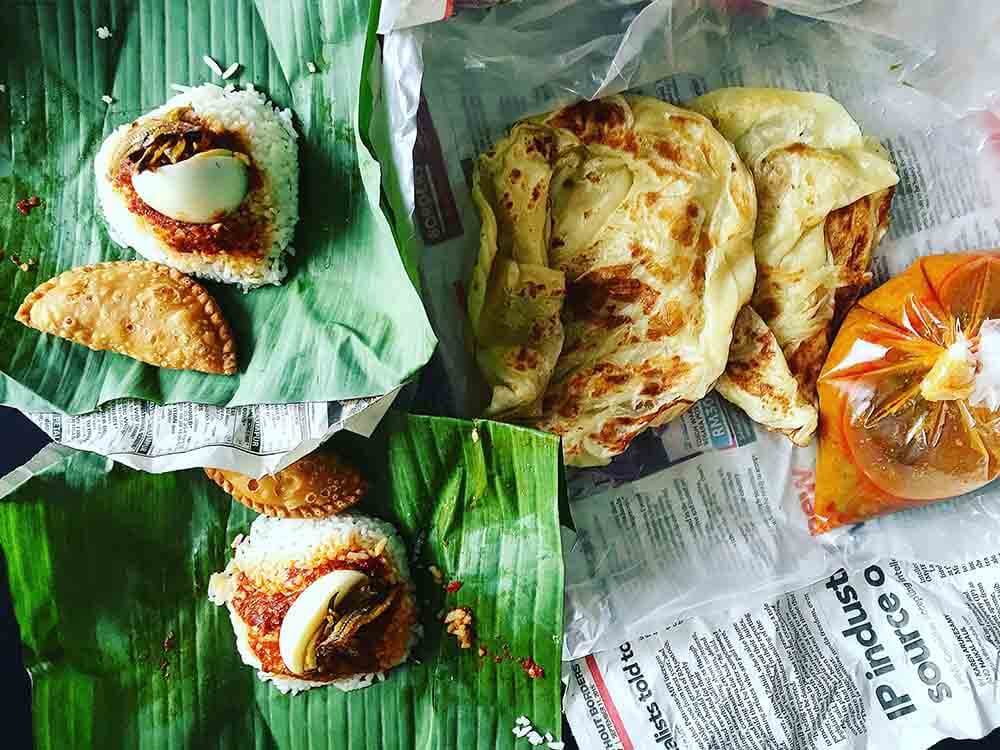
Pic by Bron from Smiths Holiday Road
Nasi Lemak is a traditional Malaysian dish made from coconut rice, sambal, anchovies and a boiled egg all served in a pandan leaf. Served here with Roti Canai.
We enjoyed this dish as a street food on the island of Penang. The roadside sellers would have the perfect little triangle pockets displayed for breakfast. They cost around 10myr for 3. As a family we would each have one, the perfect on the go snack while adventuring in Penang.
If you stay and sit with the locals make sure you grab a traditional iced coffee drink to enjoy with your Nasi Lemak.
5. Banh Mi in Vietnam
By Antonio from Vietnam Chronicles
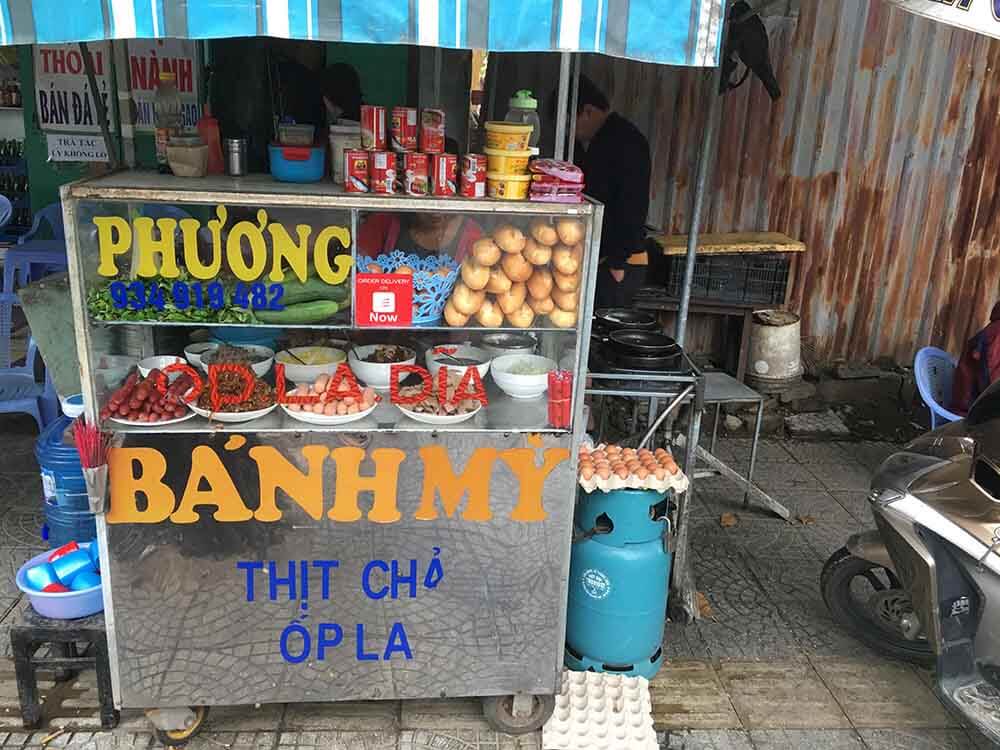
Pic by Antonio from Vietnam Chronicles
Before arriving in Vietnam, I knew only one thing – it’s a country for foodies. And I wasn’t wrong. The hardest part when it comes to Vietnamese food is to pick among so many choices, tastes, spices… One of the first dishes I’ve tried upon landing in Hanoi’s airport was an iconic Banh Mi, a baguette sandwich filled with herbs, vegetables, meat or eggs. It’s a very simple dish that can be consumed as a breakfast, lunch and even dinner.
The making of Banh Mi is a pure art since everyone prepares it differently using variations of herbs and spices. I really got hooked up on Banh Mi and soon it became a part of my morning routine – eating Banh Mi and enjoying a strong Vietnamese coffee.
I was on a mission to find the best Banh Mi in Vietnam and after a year of traveling around Vietnam, I’ve finally found it. The older energetic lady who has a small street shop next to my apartment in Da Nang is making the best Banh Mi and just observing how she is mixing the herbs and spices is a pure pleasure.
6. Thukpa in Nepal
By Zheng from Swing Abroad
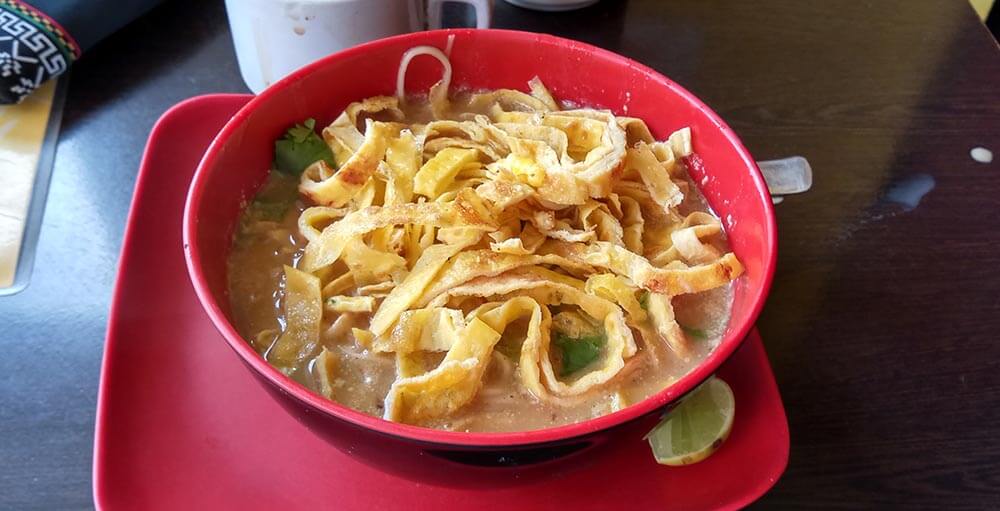
Pic by Bec from Wyld Family Travel
During my backpacking trip in Nepal, I realized that Nepal has more great foods than I previously imagined. One of the dishes that kept me wanting to visit Nepal again is the Thukpa.
Thukpa is a noodle soup originated from eastern Tibet. This dish can be found in almost every restaurant in Kathmandu city, however there is a catch. Every restaurant has its own unique recipe for preparing their own Thukpa.
Chances are you will be served a completely different noodle soup compared to the Thukpa you’ve eaten in the previous restaurant.
I think this is the reason why Thukpa is more underrated than other dishes, such as Momo. Even though I never tasted a truly authentic Thukpa, I’ve never been let down even after trying the Thukpa in more than 10 restaurants.
Thukpa is a must-try especially if you’re visiting Nepal in the winter. The flavorful thick broth will definitely warm your stomach up and brighten up your mood for the day.
If you’re in Nepal and not sure where to try it, head to Muktinath Thakali Kitchen in Thamel, they serve the best Thukpa I’ve ever had.
If you’re traveling in Nepal, other than trying the underrated Thukpa, you’ll definitely enjoy visiting the underrated town of Bandipur in Nepal!
7. Niu Rou Xian Bing in Xi’an, China
By Bec from Wyld Family Travel
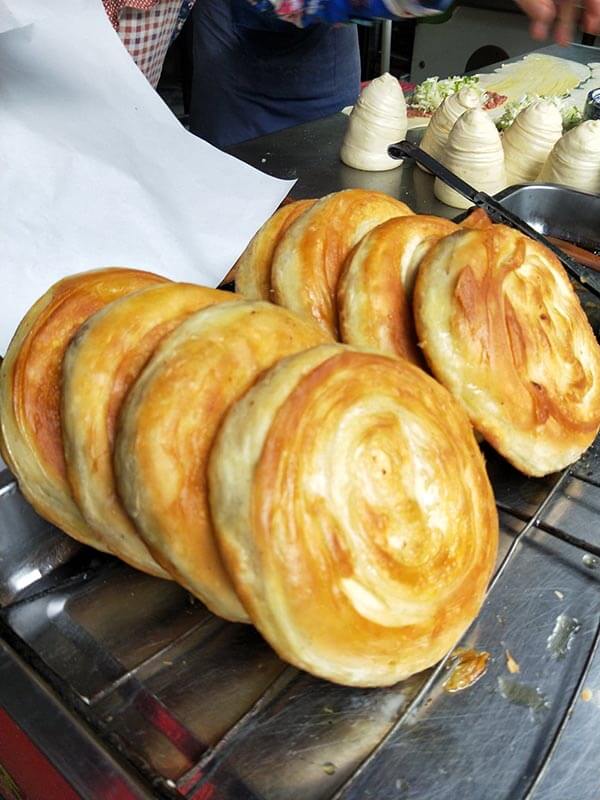
Pic by Bec from Wyld Family Travel
We had been warned a lot about food in China so our first thing to do was find a food tour in the cities we were going to and in Xi’an it was the best thing to do.
Our food tour started in the morning and as the Chinese pie is a breakfast food it was one of the things we tried first. It became our all day, go to food!
The Chinese pie or Niu Rou Xian Bing as it is traditionally known is a minced-meat-flavoured with spices. It is then wrapped in pastry and deep-fried and it is totally delicious.
Many of the small street stalls you will see selling it in the Muslim Quarter in Xi’an have their own special recipes so you will never quite know the exact spices they have in there.
We got to watch a third-generation man hand make every single one in his shop as his sister and brother took order after order to a line that went halfway up the street!
You can pick them up early in the morning normally until they are sold out but if your stall is popular it may seel out very quickly.
While they are best eaten hot and straight from the stall as you are wandering the street they can also be put in the fridge to be eaten later. We did this plenty of times with our fussy daughter and they were still amazing.
8. Death Chicken in Thailand
By Bec from Wyld Family Travel
‘Don’t eat the chicken’ It had been drilled into me over and over again from nearly everyone that had travelled through Thailand. But at some point we knew we were going to have to have some as it was nearly the only meat on sale and Chiang Mai was the pace it happened for us.
There was a little lady just down from our hotel who had a little cart that sat behind her gate during the day but at night it magically turned into the cart of awesome-ness deep-fried chicken or death chicken as our family came to know it as.
She would wheel out her cart at about 4.30, right to the side of the busy road and within minutes the top was covered in the tasty morsel that we ate nearly every day. I don’t know what it was coated in but it was delicious and perfectly cooked every single time.
As cars raced by and the sun beat down on it I was always worried that maybe once we would pick up a piece that may not have been great but then I realised that it is a common way to sell chicken in Thailand and so far we’d been lucky!
We also found the same set up at the Krabi night markets. It was a great cheap meal and one we all enjoyed and so did a lot of people who wold stop in cars, on foot and on a motorbike to pick up this ladies amazing chicken!
9. Sri Lankan Kottu
By Yulia from That’s What She Had
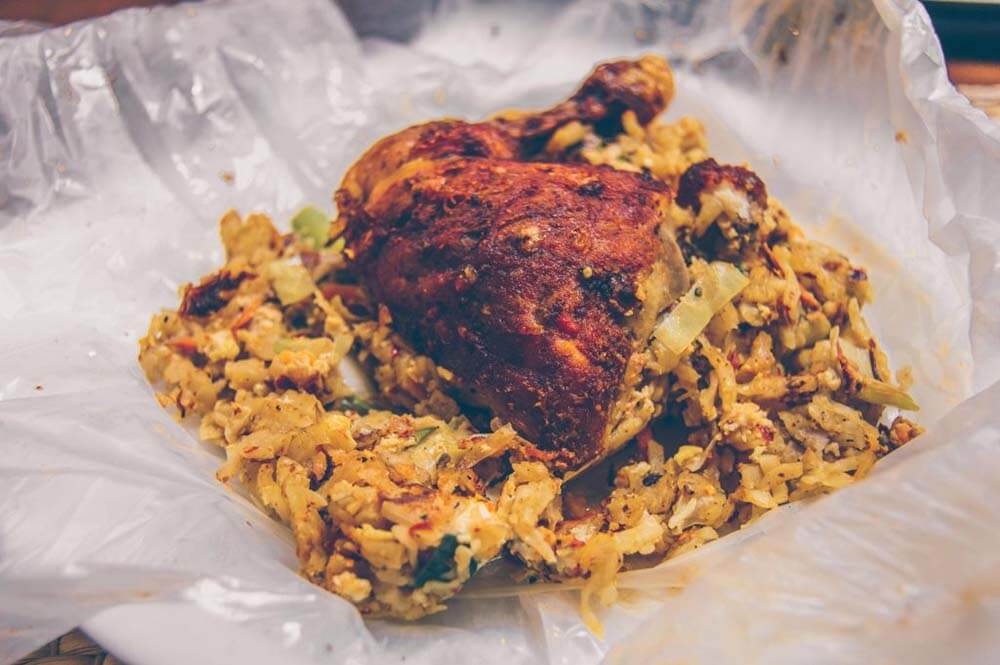
Pic by Yulia from That’s What She Had
I always say that the way to recognize there’s kottu cooking nearby when in Sri Lanka is not by its smell, but by the distinct sound. How many street foods can boast that?
You see, making kottu is not unlike making music. Only instead of musical instruments the cook uses two metal blades to chop and mix the ingredients on a grill. The clash of metal on metal is what you hear before you see or smell the actual dish.
So what is kottu? Only the best, fattiest, carb-filled, heart-and-soul-warming dish you’ll ever try. The base is made of godamba roti, incredibly thin, oily, stretchy dough that is cut into thin stripes.
The cut-up stripes of roti are then mixed with vegetables, meats, cheese, and spices right on the grill. The two blades are used to further chop the roti into smaller pieces and mix all the ingredients together.
You can choose between vegetarian kottu, chicken or beef kottu, or cheese kottu (not my favorite, but if you are ordering this after a crazy night out — fatty cheese kottu is just what doctor ordered). You can also ask to add less or more spices.
Kottu is usually a dinner-time dish, but you can find a few 24-hour kottu restaurants in Colombo, the capital of Sri Lanka.
10. Ddeokbokki in Seoul, South Korea
By Max from Dame Cacao
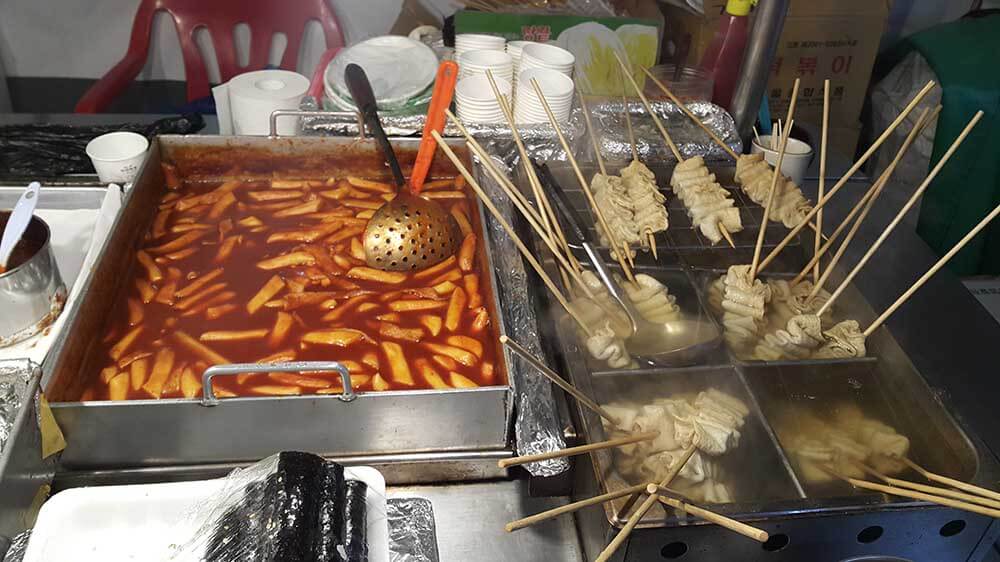
Pic by Max from Dame Cacao
One of the most typical street foods in Korea, ddeokbokki (떡볶이) is best described as glutinous rice cakes drenched in a spicy red sauce. The snack is most often served in paper trays alongside processed fish cakes called odeng or eomuk (오뎅 or 어묵).
The fish cakes are either brushed with soy sauce and eaten separately, or dipped into the spicy sauce depending on preference.
To make the signature spicy sauce in which the rice cakes are cooked, the chef uses the same Korean red pepper flakes— called gochugaru— to color and flavor the dish.
This lends a very particular taste to the experience, which may even remind you a bit of kimchi, which is prepared with the same red pepper flakes.
Ddeokbokki is sold in small stalls in all of the markets in Korea, and even along the streets in small cities and towns.
Depending on the size of the serving and the location of the stand, it costs anywhere from ₩1000-5000 ($0.80-4USD) to buy a tray of ddeokbokki, fish cakes optional. You can’t miss a taste of ddeokbokki on your trip to Seoul.
11. Bánh Rán Mặn in Hanoi Vietnam
By Skye from Skye Travels
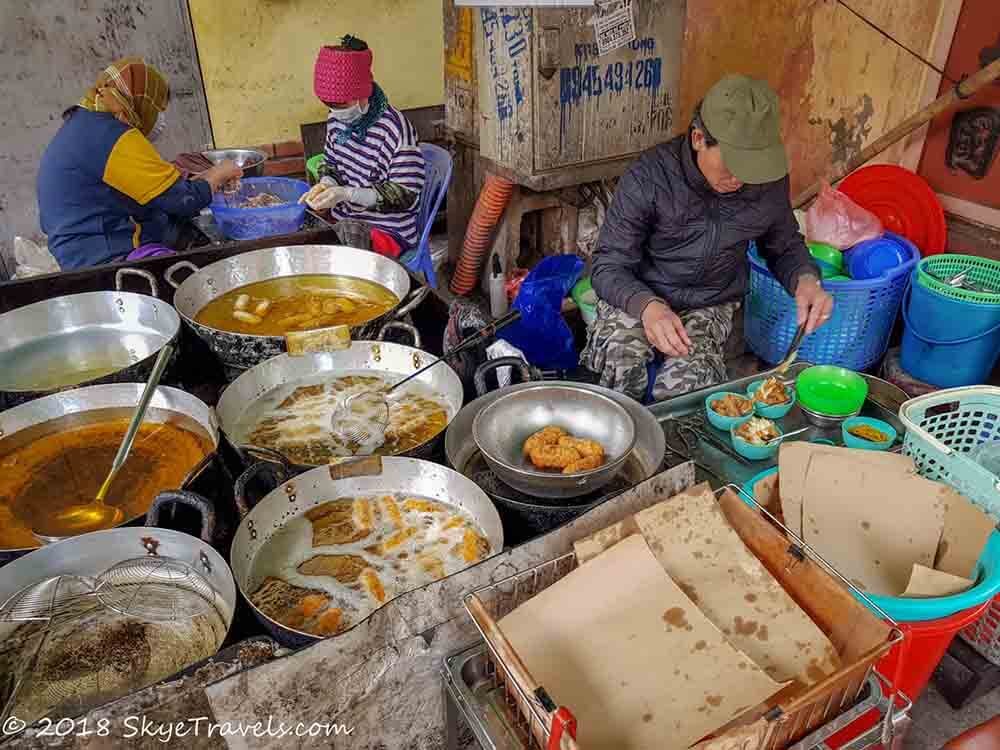
Pic by Skye from Skye Travels
The first meal I had in Hanoi was bánh rán mặn. These street food treats aren’t easy to find, but are probably one of my favorite meals in all of SE Asia! The name translates to “savory donuts” but is known in Vietnam as meat buns (as different from the famous steamed buns).
Bánh rán are donuts made with rice flour and flavored with sesame seeds. The mặn variant has pork or beef inside. They are triple deep-fried before being cut up into a bowl and mixed with pickled vegetables and sweet chili sauce.
The stand I found in Hanoi was on Google Maps, but without an actual name. An old man sat on a seat while two women quickly prepared the rice flour buns, dropping them in the first pot of boiling oil.
The man then transferred them to the second and third pots at the right time before putting them in a metal sieve to drip the oil off.
He didn’t speak a word of English, so I just pointed to the bánh rán mặn, held up two fingers, and then pointed at the Bánh rán, indicating I only wanted one.
He grabbed a small plastic bowl, cut up the two meat buns with scissors, and topped them with pickled vegetables and hot sauce, with the sweet bun on the side. My total bill: $1!!!
12. Cao Lầu in Vietnam
By Alex from Get out with Kids
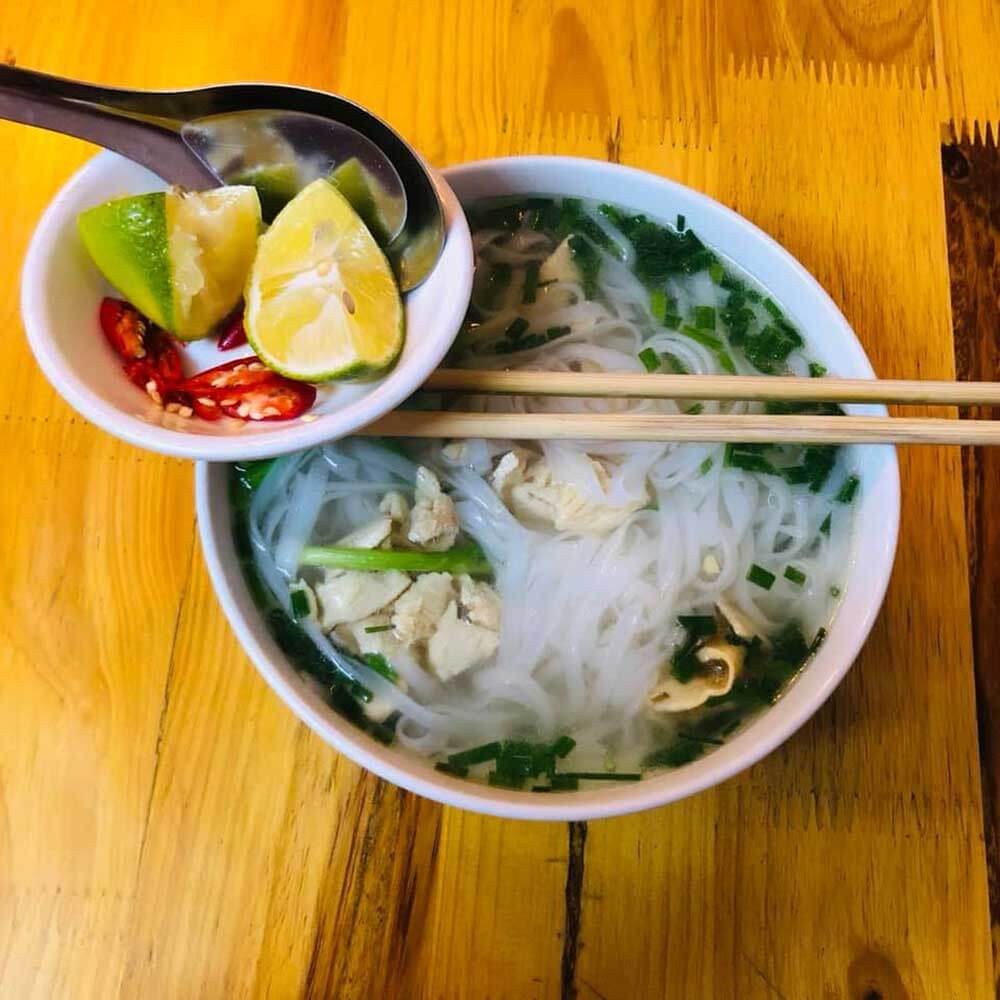
Pic by Alex from Get out with Kids
Cao Lầu, also called Vietnamese Noodle Bowl, is one of our favourite street food meals to eat in Hoi An with kids. It hails from Hoi An, but it can be found across the country.
Whether you are looking for an inexpensive meal, something tasty or just a quick meal, Cao Lầu fits the bill for each of these.
On our most recent visit to Hanoi, I had a head cold and felt like something warm and easy that would fill me up but wouldn’t be too stodgy or heavy. Cao Lầu!!
Cao Lầu can vary depending on where you get it or who makes it but generally the main ingredients of Cao Lầu are rice noodles, meat, greens, bean sprouts, and herbs.
It is usually served with a small amount of broth, also this can vary too. The meat used is typically pork, either shredded or sliced, but I have also had it with chicken and/or prawns.
Look out for this delicious, local cuisine next time you are in Vietnam, it’s a good alternative to Pho!
13. Suja (Butter Tea) in Bhutan
By Anwesha from Going Places with Anwesha
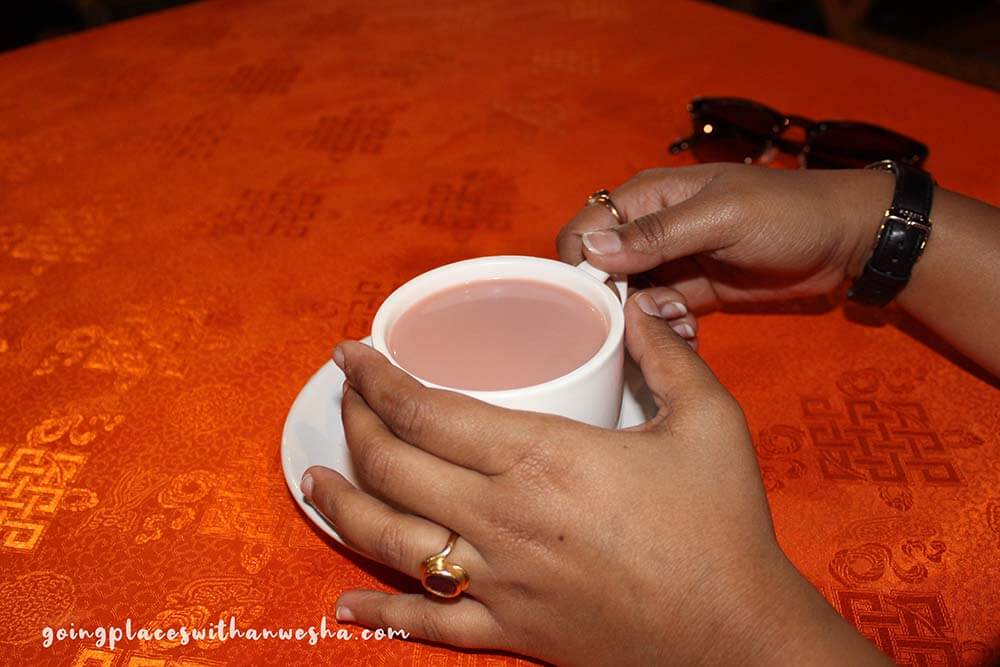
Pic by Anwesha from Going Places with Anwesha
Suja is a staple drink for the people in the Himalayan countries, especially in Bhutan.
Bhutan doesn’t have any street tea stalls like India, but you can get Suja aka the Butter tea in almost all the restaurants. It’s a ‘go-to’ drink for the Bhutanese people and goes well with all the meals for all the occasions.
Suja is traditionally made with fermented yak butter but nowadays due to cow butter being readily available, Suja is mostly prepared with cow butter.
After the tea leaves, milk and butter are added to the tea, it’s churned using a wooden churner. The saltiness of the drink depends on the amount of butter added to it.
When the weather gets chilly in the valleys especially during the winter seasons, drinking Suja first thing in the mornings will lift your spirits and boost your energy. The creaminess in the Suja will prevent your lips from chapping as well. So, don’t forget to sip some Suja on your next visit to Bhutan.
14. Idli in South India
By Penny from Globe Trove
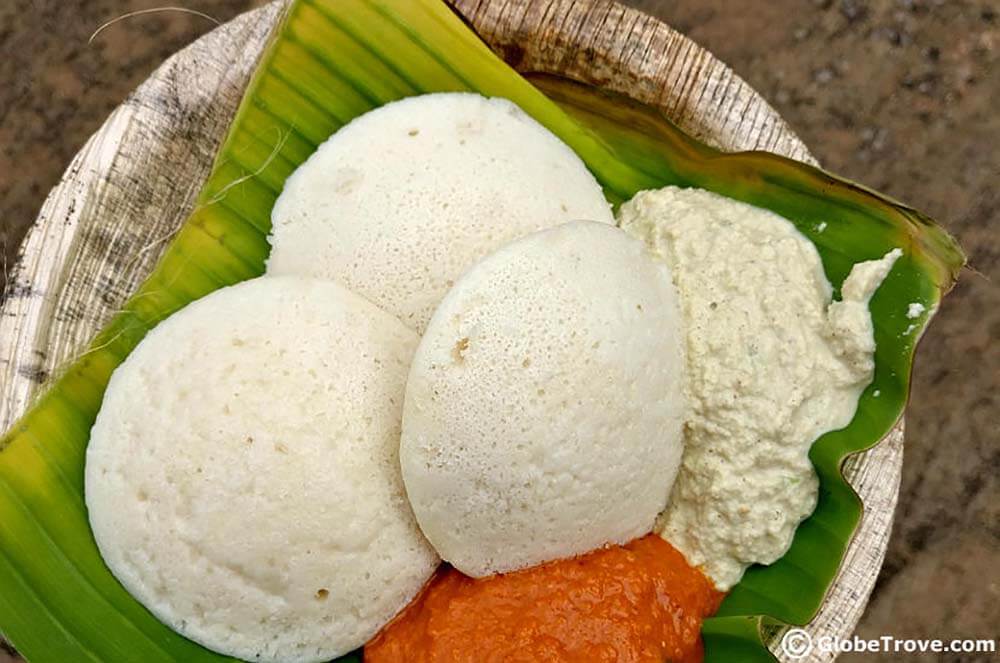
Pic by Penny from Globe Trove
One of my favourite items of street food in India comes from the south of the country. It is a dish that is called idli. This soft and fluffy item is a kind of rice cake that is made of fermented batter and then steamed.
One of the reasons that I love it is because it is probably the healthiest of the snacks you could get on the Indian streets. While alone it does not have much taste on its own, idlis are delicious when served piping hot with an accompaniment of chutneys and sambhar.
Idlis can be paired with any of the Indian curry dishes in case you are looking for a spicier fare. In fact, I always advise foreigners to choose idlis when they first arrive in India.
It helps since many people can’t tolerate the Indian spice. The hot delicious idli is a safe bet and since it is cooked and is fermented, you are highly unlikely to fall ill eating it.
15. Kueh in Brunei
By Penny from Globe Trove
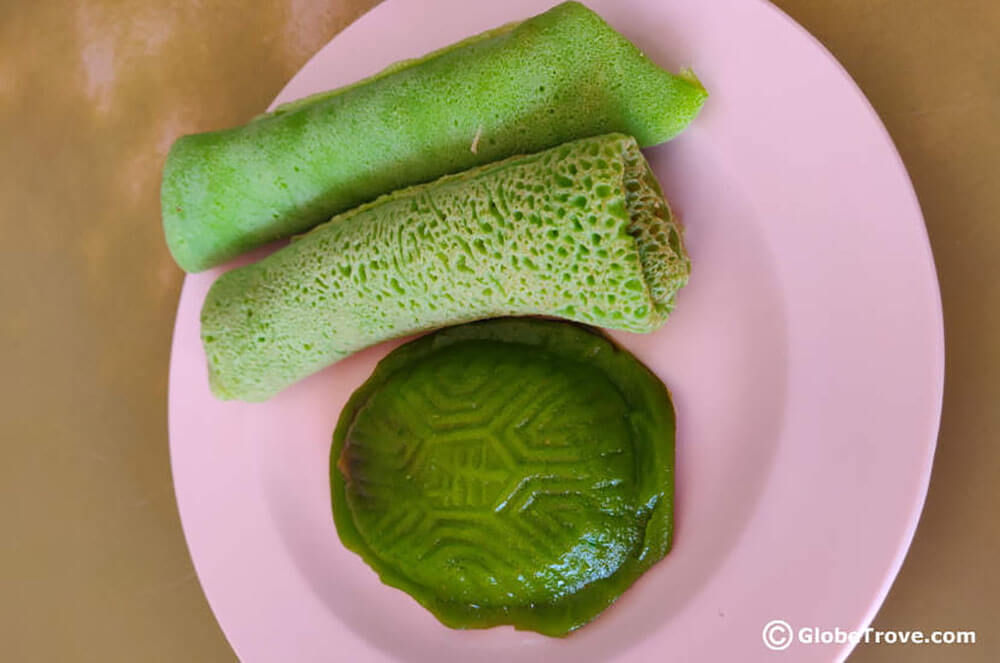
Pic by By Penny from Globe Trove
A lovely item of street food in Brunei is a dessert called Kueh. To be honest however, Kueh can be both savory or sweet. Made of rice paste, this item is then stuffed before being steamed.
The most common stuffing that I have come across is made of bean paste. These bite-sized delicacies can be found across the country and even in other parts of South East Asia.
The interesting part about this item of street food is that it isn’t confined to being served at a certain time of the day. In fact, if you pass a local restaurant or a roadside stall you are bound to find Keuh on the list of street food. We used to pick them up as a snack.
They also served as a great refreshment on our treks through the many different forest reserves that we visited in the area. It is something that I highly recommend to try.
16. Gorengan in Indonesia
By Chantell from Travel for your life
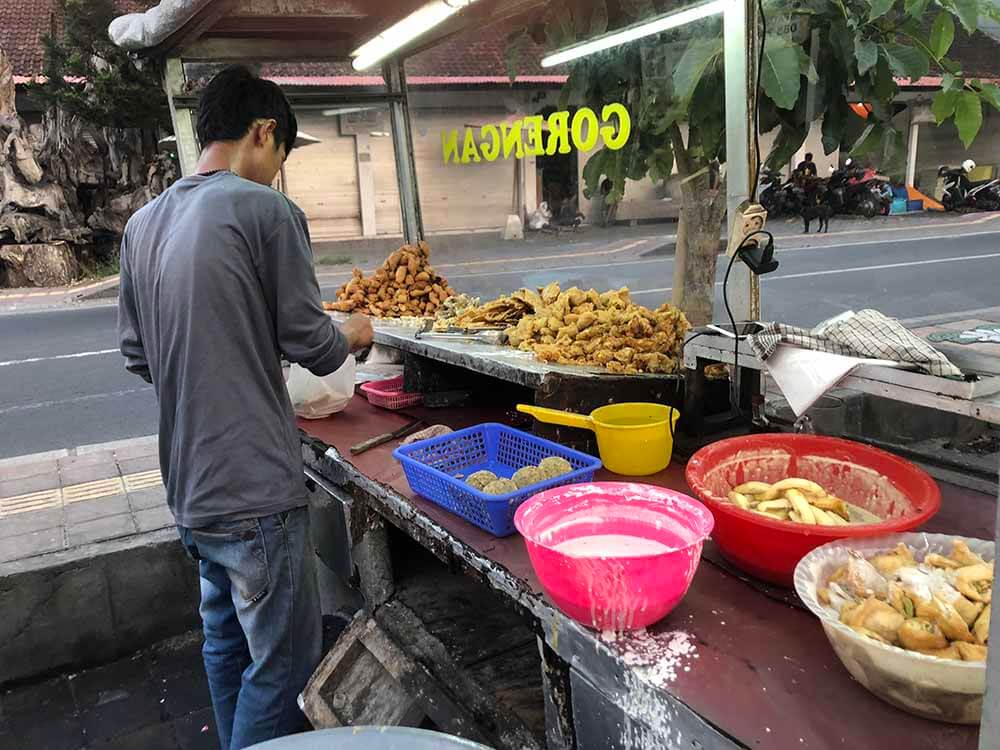
Pic by By Chantell from Travel for your life
Gorengan in Indonesia is a selection of delicious fried snacks you can find on the side of most roads. They have everything from fried tofu, cassava, tempe, banana and more.
It costs about 1,000 IDR per item ($0.70 USD) and generally what people do is they go up and ask for a mix and state the price they want that mix to come to.
5,000 IDR would give you a good selection of items but if you’re really hungry and want more than a little snack 10,000 IDR will make it feel like you’ve ordered masses!
The handy thing about getting a mix is that at least then it doesn’t matter if you don’t know what each item is or how to say them in Indonesia. I still don’t know what each item is and I’ve been in Bali for years.
If you would prefer to just try a couple, however, my personal favorites are the tempe (same word in Indonesian) and banana (pisang in Indonesian). For those who love a bit of spice, you’ll be happy to know they come in a bag with raw green chilies!
17. Bun Cha in Hanoi, Vietnam
By Marianne from Mum on the Move
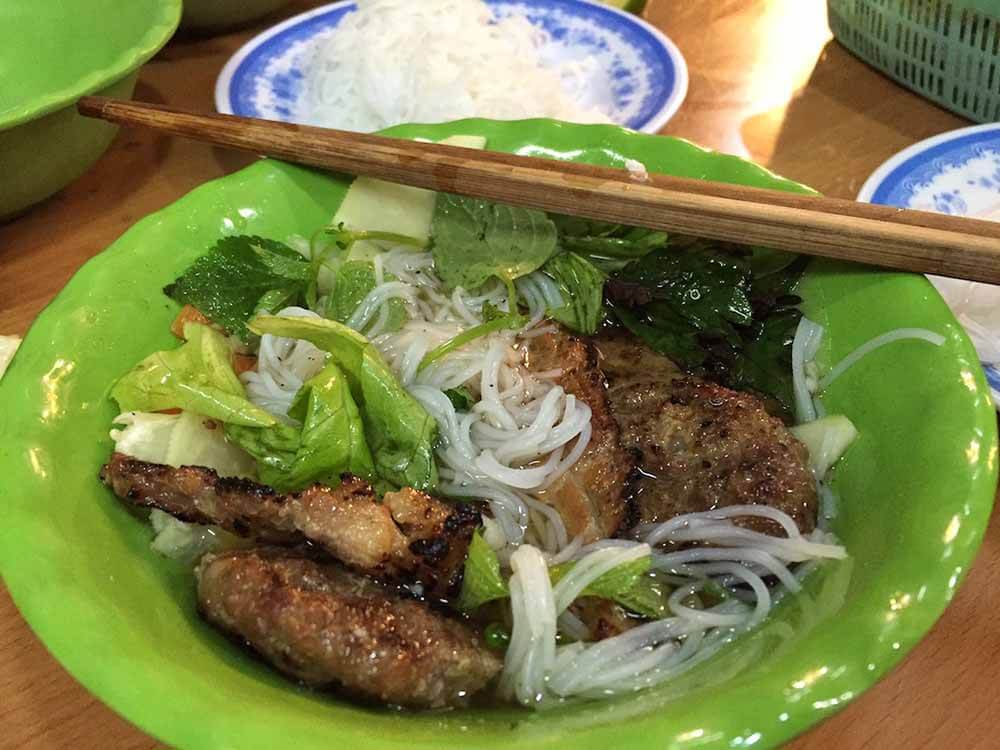
Pic by Marianne from Mum on the Move
Bun Cha is one of the most famous street food dishes in Hanoi, and little wonder! It is delicious! Bun Cha is basically a pork noodle soup, but way better than any other pork noodle soup you have tried.
The star ingredient of Bun Cha is the pork patties, which are grilled over a smoking barbecue until they are almost caramelized, giving them an amazing sweet smoky flavour.
The chargrilled pork is then served in a tangy soup, accompanied by white rice noodles, fresh herbs, lettuce and cut chillies. Vinegar from pickled vegetables in the soup helps to cut through fattiness of the pork, while the lettuce and herbs add a freshness to the dish that is so characteristic of Vietnamese cuisine.
You can find Bun Cha in streetside restaurants all over Hanoi – just look for the smoke billowing from a barbecue at the front door.
18. Burekas or Bourekas in Israel
By Maya & Sari from Chasing Lenscapes
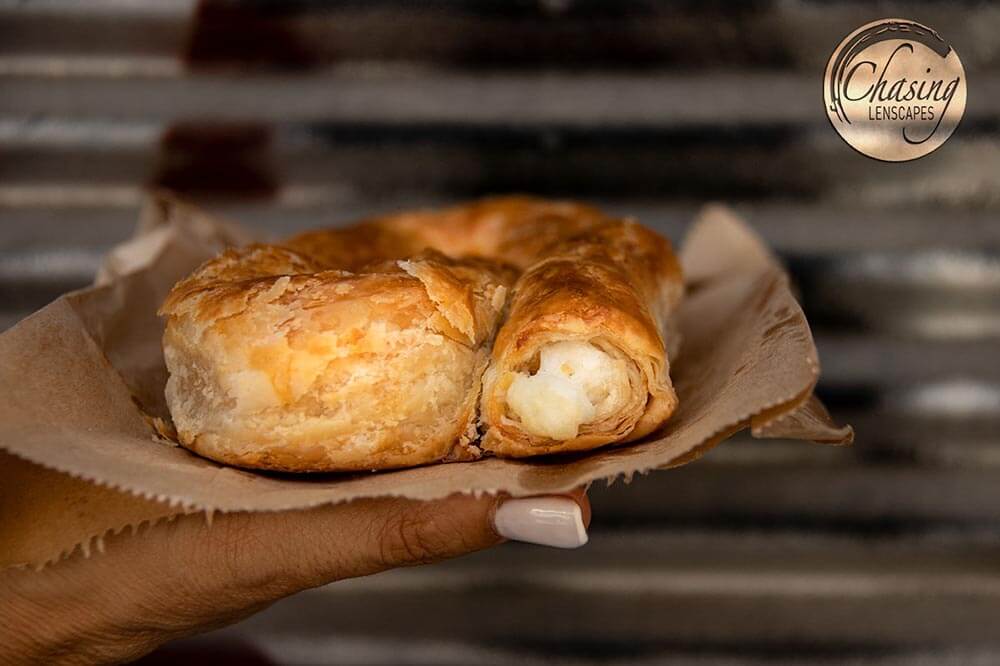
Pic by Maya & Sari from Chasing Lenscapes
Burekas or Bourekas are Israel’s take on the well-known Börek that can be found in Turkey, the Balkans, Eastern Europe and many other Middle Eastern countries. Don’t know about you, but a doughy pastry filled with vegetables, meat or cheese sounds like heaven to us.
It’s delicious, filling and easy to devour on the move which makes it excellent street food. Israel has always been a melting pot of cultures, and as always in such cases, the mixture of cultures is reflected in the Israeli cuisine.
What are Israeli burekas made from? Israeli burekas can be made from different kinds of dough such as phyllo dough, puff pastry and even shortcrust pastry (then it is called Borekitos). It is filled with different Israeli cheeses, vegetables or even minced meat.
You can find huge burekas or tiny and elegant ones. Their shape can vary from triangle, square, rectangular or spiral, and they can be sprinkled with sesame seeds or seeds of nigella sativa that look like black sesame seeds (ketzach in Hebrew).
The most classic burekas is probably the cheese-filled phyllo dough burekas, and it is usually served with a hard-boiled egg. Israelis love their burekas for breakfast, lunch or dinner or just as a snack.
There are burekas kiosks and eateries that serve huge burekas as a meal but you’ll also find smaller burekas in bakeries and convenient stores.
If you’d like to try one of the best Israeli street food out there, make sure to try a burekas when you visit Israel. For more recommendations about Israeli food and what to buy in the local markets, you can check our Levinsky Market Guide.
19. Odeng Tang in South Korea
By Callan from Once in a Lifetime Journey
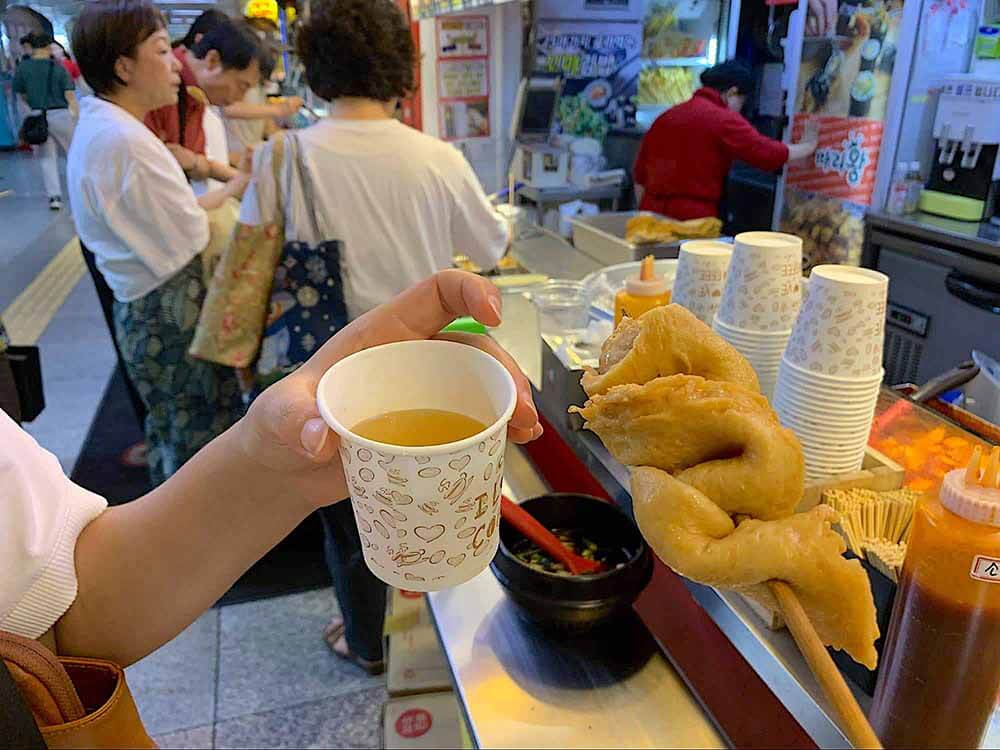
Pic by Callan from Once in a Lifetime Journey
One of the best street foods to try in South Korea is the sweet and salty odeng tang or fishcake broth. Odeng is borrowed from the same Japanese dish called oden which is a sort of mashed up tube or flattened rectangle that consists of white fish, potato starch, sugar and vegetables.
This super cheap street food is best in winter as the odeng is cooked in a deliciously hot broth. The odeng comes skewered on a stick and you pay per piece, but the broth can be topped up as many times as you want into the paper cup. Vendors can be found almost anywhere, but are particularly present in or near subway stations as this is where most of the foot traffic is. It’s basically self service where you pick what you want and dish up as much broth as you like.
The South Korean street food is also called eomuk tang and is a great companion with the other popular roadside cuisine tteokbokki. It’s the perfect accompaniment to the spicy rice cakes.
Do as Koreans do and stand on the side of the road, munching on your skewer and slurping the boiling broth while watching the human traffic flow by.
20. Goi cuon in Vietnam
By Delilah from Our Travel Mix
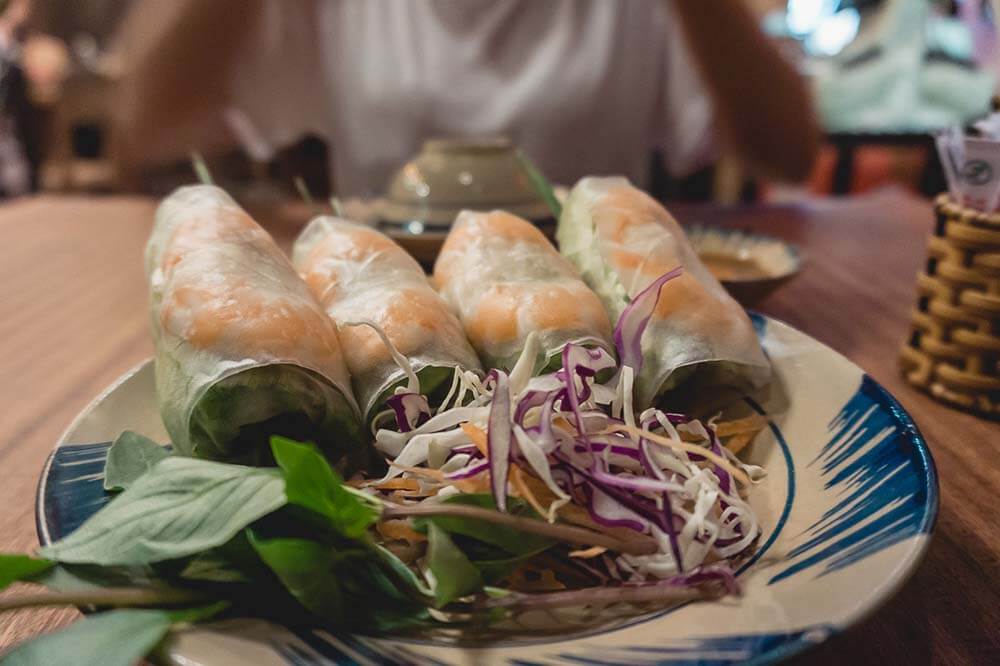
Pic by Delilah from Our Travel Mix
Goi cuon is better known to westerners as the fresh spring roll or summer roll. Unlike the spring roll (cha gio), these appetisers are not deep-fried, making them a healthier choice, and a great dish to enjoy during the hot Vietnamese weather.
Vermicelli noodles (bun), pork, prawn and lettuce are rolled by hand in rice paper (banh trang). Some variations may include bean sprouts and assorted vegetables.
Goi cuon is served at room temperature. With every bite you’ll taste fresh herbs, usually mint, perilla, cilantro and chinese chives which gives the dish a flavourful burst.
Enjoy fresh spring rolls with fresh chilli and a dipping sauce called tuong cham goi cuon. The hoisin and peanut concoction complement the flavours perfectly.
Goi cuon has been believed to have been introduced to the Vietnamese by Chinese immigrants. Nowadays, they’re a very popular appetiser for locals and tourists alike.
You won’t have trouble finding them in Vietnam – they’re available as street food and at high-end restaurants in Ho Chi Minh City, Hanoi & other major cities.
On the street and local eateries, you’ll get four of these rolls for 40,000 VND – that’s less than $2 USD! In restaurants, goi cuon is still incredibly affordable at around 80,000 VND.
21. Xiaolongbao in Shanghai
By Ivan from Mind the Travel
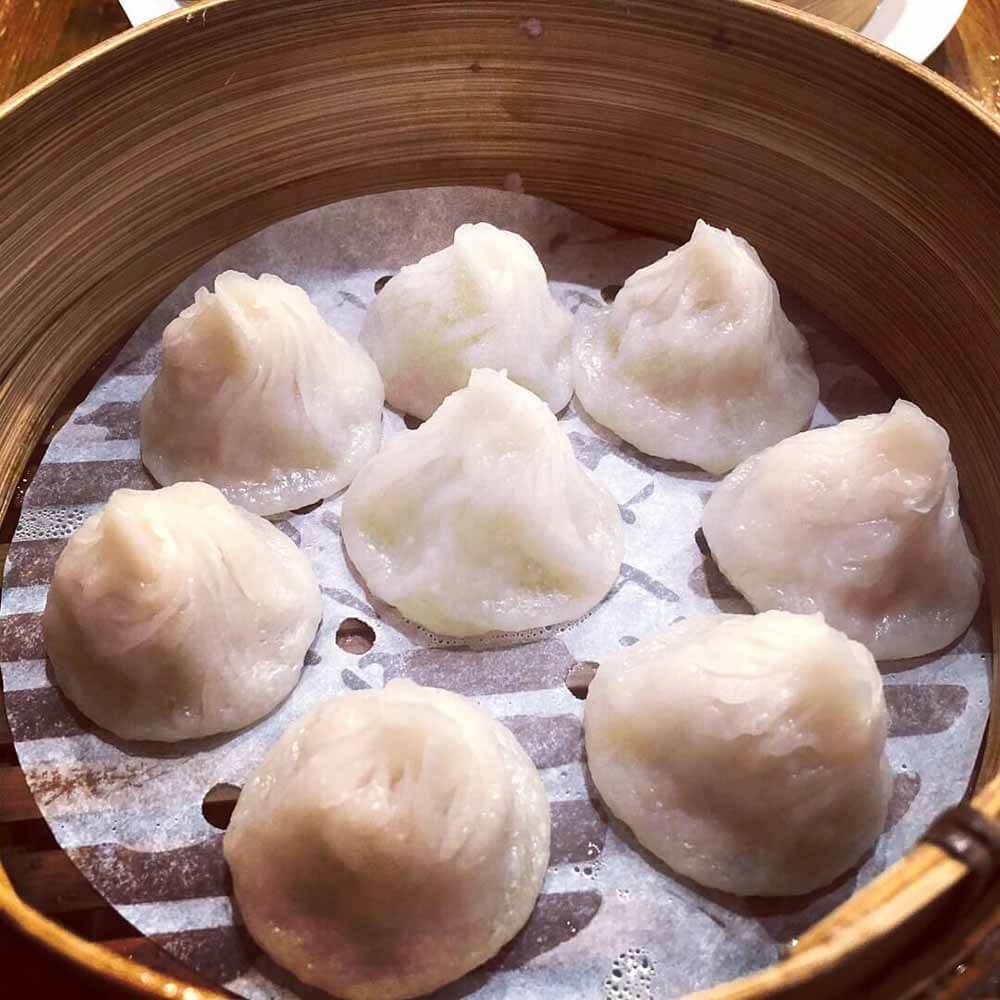
Pic by Ivan from Mind the Travel
Originating from the town of Nanxiang in the suburbs of Shanghai, Xiaolongbao little steamed buns can also be but found throughout China.
According to a legend, the inventor added aspic to pork mince upon steaming. The aspic would become liquid, thereby filling the inside of the dumpling with a flavorsome broth.
Xiaolongbao are traditionally steamed in bamboo baskets (xiaolong), which give them their name. The buns should not be confused with British or American-style dumplings nor with other larger varieties of tang bao.
There are actually several regional varieties of soup dumplings today, while Shanghainese xiaolongbao is one of them.
Shanghainese xiaolongbao traditionally have heartier wrappers and contain a larger pork meatball in a sweeter pork soup. Some other modern innovations include a mixture of minced pork, shredded vegetables, and sometimes additional meat like crab.
When perfectly folded, these small buns look so delicious that you want to eat them right away, but beware: Successful consumption of xiaolongbao requires an exquisite sense of timing.
Eat one too quickly and the broth will burn your tongue and leave you wanting to soothe it. Wait too long, though, and your “small basket buns” will be overly cold.
Any xiaolongbao connoisseur knows that you must temper the soup dumplings’ heat by dipping them, ever so gently, into a tiny saucer of vinegar.
Alternatively, to make things easier, you can extract the broth from your xiaolongbao before eating the rest of it and make them a bit cooler. Loud slurping is half the fun of drinking the soup broth.
22. Fried Tarantulas in Cambodia
By Sean from Living out Lau
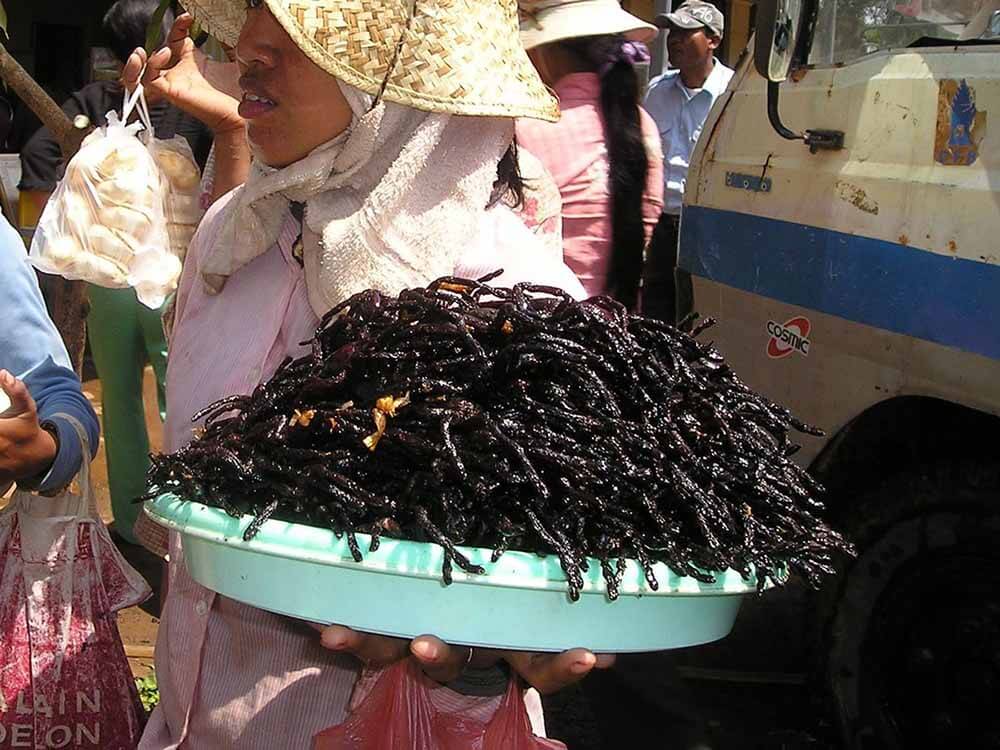
Pic by Sean from Living out Lau
Do you have a fear of spiders? Well, what’s a better way to overcome the fear by eating your enemies. In Cambodia, especially the town of Skuon, you can find fried tarantulas as a popular street food.
Why? I have no idea. Maybe Cambodians are secretly a group of sadists who like to watch people suffer.
Fried tarantulas are definitely not foods you try because you love the taste, but more of a food to try just to say you tried it. I mean who likes the feeling of biting into a tarantulas abdomen and have all its guts, intestines, and fecal waste burst in your mouth?
Not this guy. The legs are a little more bearable because they are deep-fried to crispiness. Either way, you will be making weird faces after putting it in your mouth. Your brain might even shut down for a moment, who knows?
So when you visit the biggest religious complex in the world, Angkor Wat, make sure you scout around for some fried tarantulas as well. I can guarantee you that both will be unforgettable experiences.
23. Kathmandu Lassi in Indra Chowk, Nepal
By Kali from Kali Travel Blog
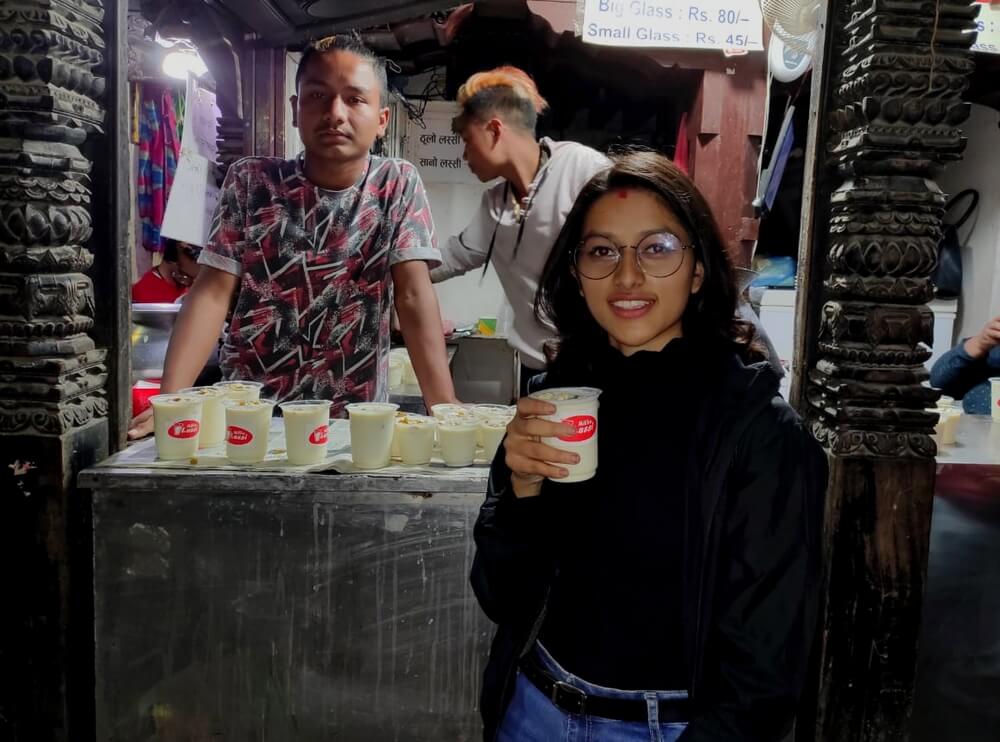
Pic arranged by Kali Travel Blog
If you find street food in Asia fascinating you’ll just love the lassi house in Indra Chowk – it’s on the frontage of a genuine Hindu Temple in the middle of old Kathmandu and, as you can imagine, incredibly unique.
Nepali lassi is made freshly from churned buff milk, yes that’s right! The majority of Nepalese are of Hindu faith, and cows are sacred animals, so milk is taken from the water buffaloes that graze in the lush mountain pastures of the Himalayan foothills.
Indra Chowk is a chaotic little square right by the Asan Market street bazaars where the locals like to congregate and just up the road from famous Kathmandu Durbar Square, the ancient World Heritage Site. You can’t really miss it if you’re heading that way.
The throng outside is usually several people deep, waiting in turn for the stall guys to scoop out a pot-full of cool plain sweet lassi from the shiny metal churns.
A few nut slivers are sprinkled on top and there you go, the most delicious yoghurty delight for only a few rupees. No wonder it’s popular.
So what does real lassi taste like? Wonderfully thick and creamy, and not overly sweet…an authentically homemade and natural treat.
24. Takoyaki in Osaka, Japan
By Jennifer from Sidewalk Safari
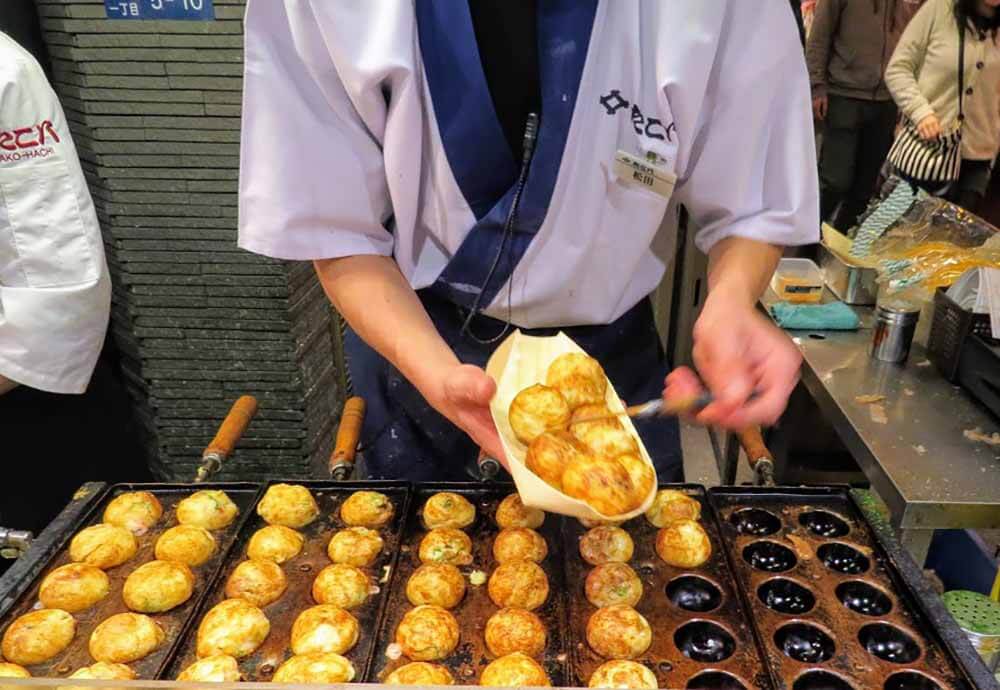
Pic by Jennifer from Sidewalk Safari
Osaka has some of the best food in Japan. Takoyaki is an Osaka street food specialty that you simply can’t miss. What is takoyaki? Put simply, they are octopus dumplings.
You’ll find vendors making takoyaki in the street in Dotonbori alongside all the bright, shiny lights situated on the river in Osaka. The crowds come to Dotonbori at night to sate their appetite and grab a drink.
Look for the stall with the longest queue because Japanese love to queue for great food, at least according to an American in the U.S. Navy stationed nearby who struck up a conversation with us.
It’s mesmerizing to watch as the takoyaki are prepared with great patience and a painstaking attention to detail. The chef swirls and flips the batter with a toothpick until a delectable creation appears. The batter goes from flat to perfectly round in a matter of minutes.
Takoyaki are served up in batches of six or eight pieces smothered in a barbecue-like sauce and topped with fish flakes (bonito).
Warning: don’t give in to the temptation to eat your takoyaki as soon as they are served. Despite how good they look and how hungry you are, they will be HOT. Tucking in right away is a recipe for burning the roof of your mouth.
Believe me, takoyaki are worth the wait both in preparation time and the requisite cooling off period.
25. Banh Thai Pancakes in Vietnam
By Ashley from World to Wander
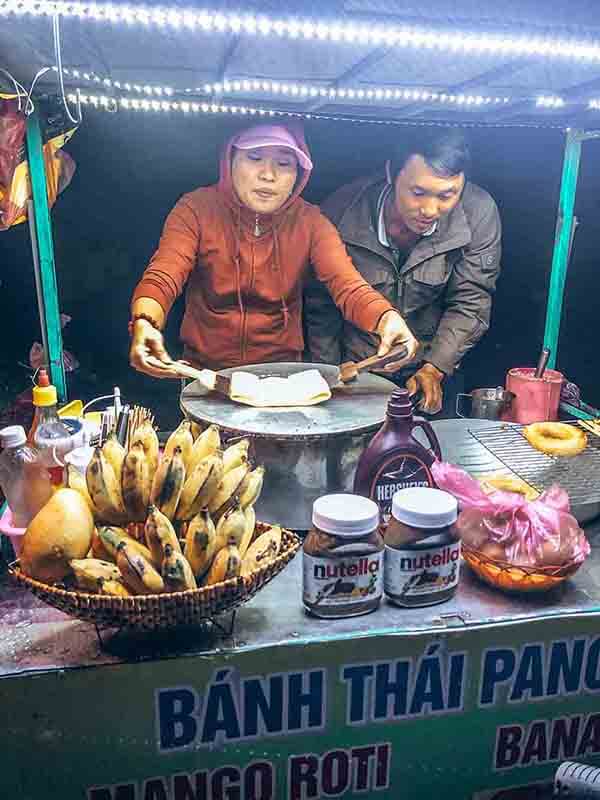
Pic by Ashley from World to Wander
Banh xeo are Vietnamese pancakes which can be slightly different depending on whether you visit the South (Saigon) or the North (Hoi An).
If you’re looking to try these while traveling in Vietnam, these can be referenced as pancakes or crepes but mention Banh xeo and someone should be able to point you in the right direction.
While in Hoi An, Vietnam, we had the pleasure of tasting Banh xeo for the first time at a night food stall.
What looked like crepes from afar, we realized these savory style pancakes were in fact made of rice powder and turmeric, topped with either bean sprouts, shrimp, pork or egg.
It’s a sweet and creamy batter mixture tasting of peanut sauce. The finished product has the shape and look much like a soft shell taco with a crispy texture. They can be rolled up with greens and onions and paired with a Vietnamese Beer like Saigon.
These Banh xeo vary in size depending on the region you’re in, Saigon has bigger pancakes while Hoi An has much smaller pancakes, so you’ll want to order a few. Try dipping your Banh xeo into some fish sauce and chili to top it off!
26. Roujiamo in Xi’an, China
By Coralie from Grey Globetrotters
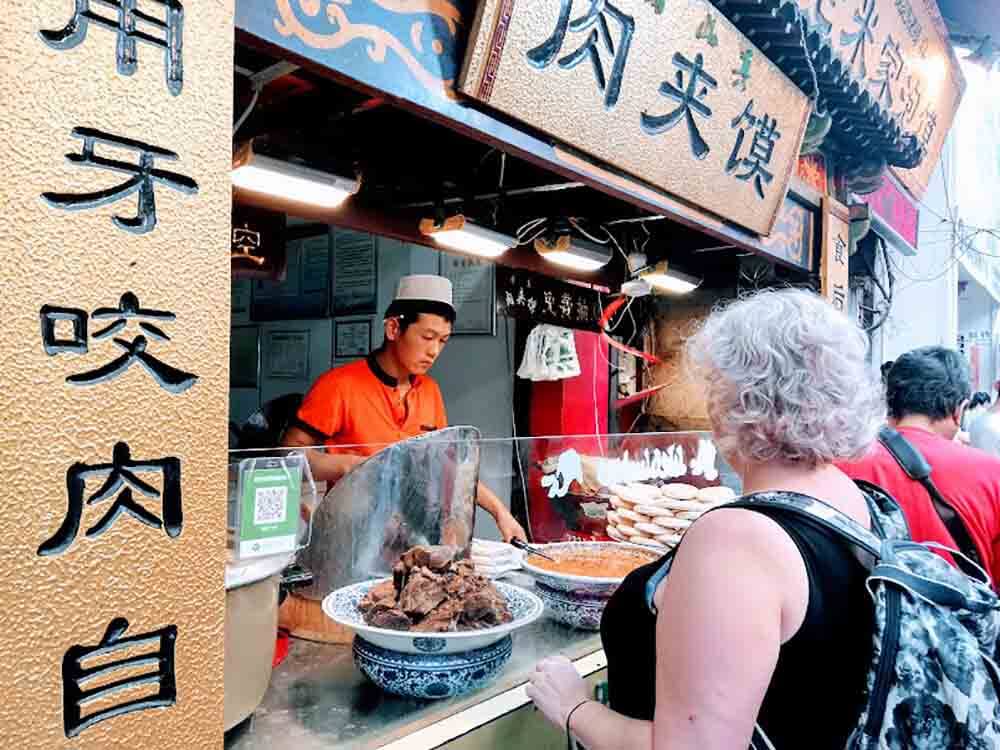
Pic by Coralie from Grey Globetrotters
The Muslim Market in Xi’an, China is the thriving hub of the Muslim community in Xi’an and the ultimate place to enjoy some of the best street food in Asia.
The streets draw you in with hundreds of colourful stalls groaning with the freshest of sweet and savoury treats, and the exotic aroma of spices hangs in the air, promising goodness to come!
These bustling streets are where all the locals flock to stroll, enjoy lunchtime snacks and socialise.
After a busy morning visiting the incredible Terracotta Warriors we couldn’t resist trying Xi’ans famous roujiamo (marinated lamb stuffed inside a freshly baked bun), the most delicious skewered squid, dripping with fierce chilli oil (yes it ran down my chin and no, I didn’t care!) and some of the best, freshest noodles we’ve ever tasted.
For less than the price of a latte at home, we felt as if we had feasted. If you’re not sure what to try, watch where the locals are queuing up – you know the food will be good!
27. B.K.’s Fries Thamel Kathmandu, Nepal
By Ankit Rana
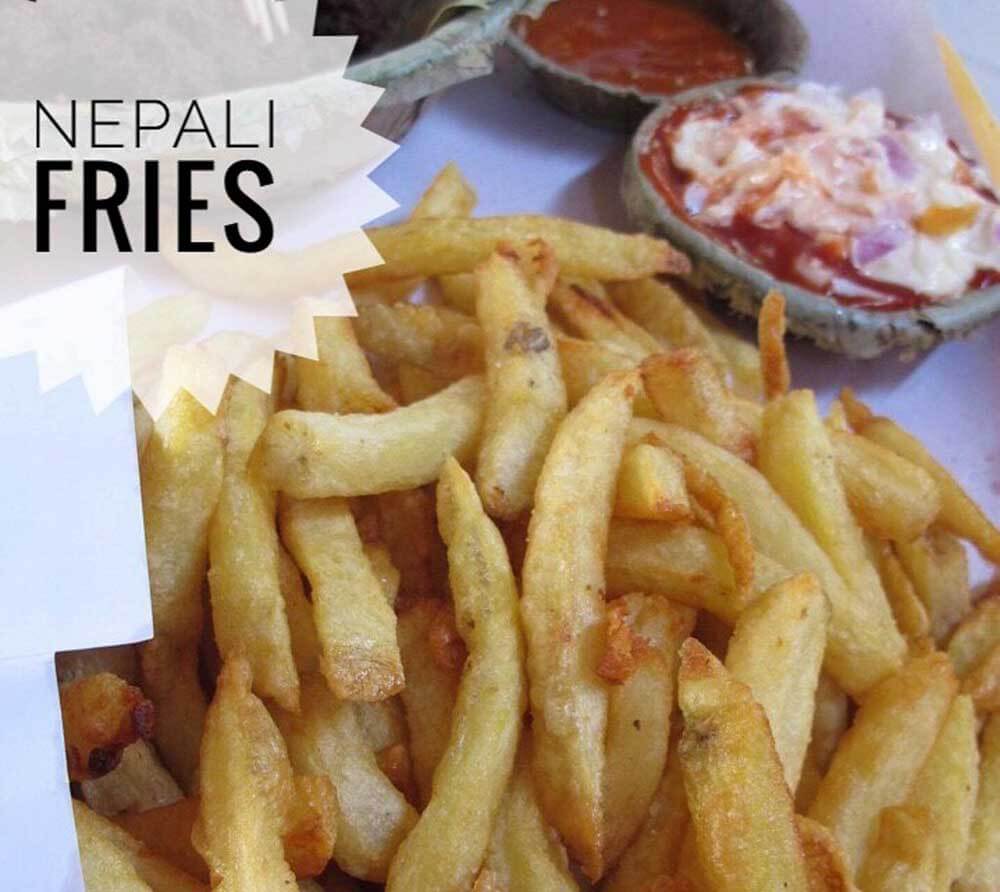
Pic by Ankit
“What do you get when you combine fresh french fries with a variety of different sauces in the heart of Kathmandu? – BK Fries.
B.K.’s place is a Friterie that is hugely popular among locals and tourists in Thamel – the tourist hub of Kathmandu. B.K.’s place serves various types of fritters (fried food) ranging from French Fries, Samosa, Momo, Spring Roll to name a few.
Their french fries combined with a unique range of sauces is the one of most popular dish in Thamel.
B.K.’s fries are bigger in size and portion compared to other eateries in Thamel. Moreover, you get to choose either Mayonnaise, Ketchup, Cocktail, Hot Ketchup, Tartar, Devil Sauce, Special Sauce, Pinda Sauce and Patatje Oorlog.
Our favorite is the Cocktail – which is a mixture of Mayo and Ketchup and served with diced onions. Next time you’re in Kathmandu – don’t forget to check it out.”
28. Char Kway Teow in Penang Malaysia
By Kirsten from Sand in my Curls
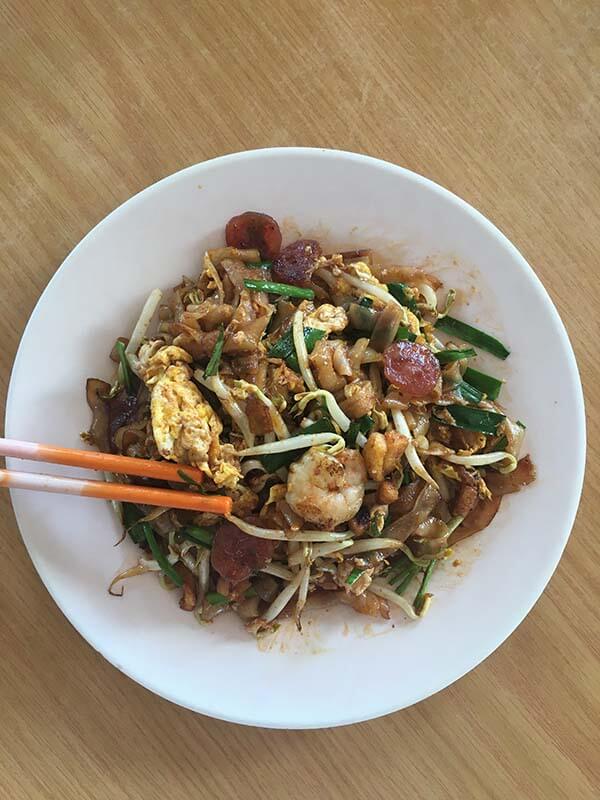
Pic by Kirsten from Sand in my curls
If you only have time to do one thing in Penang, you should eat.
When you see a line of locals waiting for food, hop in it with them. Don’t worry if it’s long; it only takes a few minutes to make each dish, so it goes pretty quickly.
One of the most famous dishes in Penang is char kway teow. It’s a Chinese noodle dish that is comparable to pad Thai.
Ask a group of locals the best place to eat this dish, and a passionate verbal battle royale will break out. Everyone thinks their pick is the best, and Penangites will debate about it for days!
It’s made of silky rice noodles cooked with soy sauce and chili. Then they add chives, egg, and bean sprouts, then top it with a couple of shrimp. My favorite addition is thinly sliced, dried Chinese sausage.
If you’re lucky, they’ll add fried lard pieces into the mix to give it an extra layer of richness.
The best, most authentic places use charcoal to fire up the wok to blazing degrees before taking a handful of each ingredient and tossing it in. The charcoal gives the noodles a smoky flavor.
In about two minutes, you’ll have a plate of absolute perfection. It’s served on a banana leaf for that extra fragrant detail.
The whole plate costs less than RM6.
29. Lok- Lok in Penang Malaysia
By Kirsten from Sand in my Curls
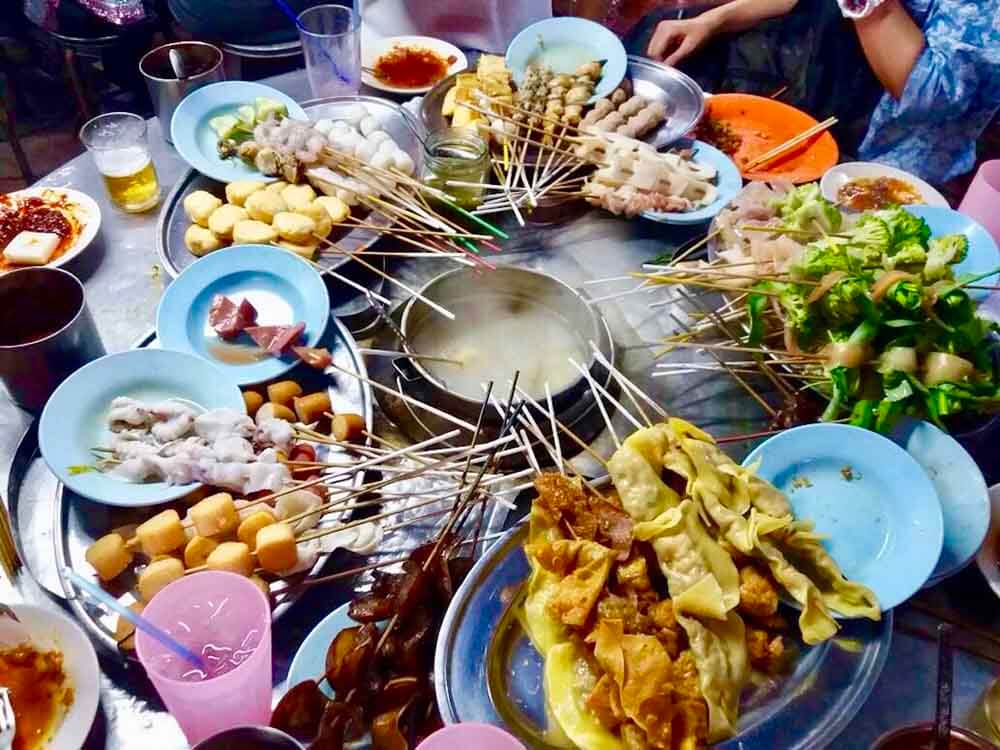
Pic by Kirsten from Sand in my curls
Lok-Lok is one of the must-eat street foods in Penang. The term lok-lok means dip-dip, which is precisely what you do. You dip a skewer into boiling water, and then you dip the cooked food into the sauce.
At a hawker center, you’ll see large round tables piled up with mounds of raw food on wooden skewers. You’ll find everything from broccoli and shrimp to offal and pig’s ears.
Each skewer has a color painted on the top of it that coincides with a price. Unless you are with a large group, you will have to share a table. In Penang, that’s a good thing. Talking food with the locals is a national pastime.
Each table has a round hole in the middle with a boiling vat of water. To cook your food, dip your skewer of choice into the water for 30 seconds to a minute. If you are unsure how long, ask your local table mates, they’ll know.
Once it’s cooked, pull it off the skewer and try all the dipping sauces. My favorites are the tom-yam spicy sauce and the lemongrass-chili.
When you are finished, hand over your skewers to the human calculator, who will count quickly in Hokkien and give you the final bill.
30. Laksa in South East Asia
By Ming Lee from Flyerism
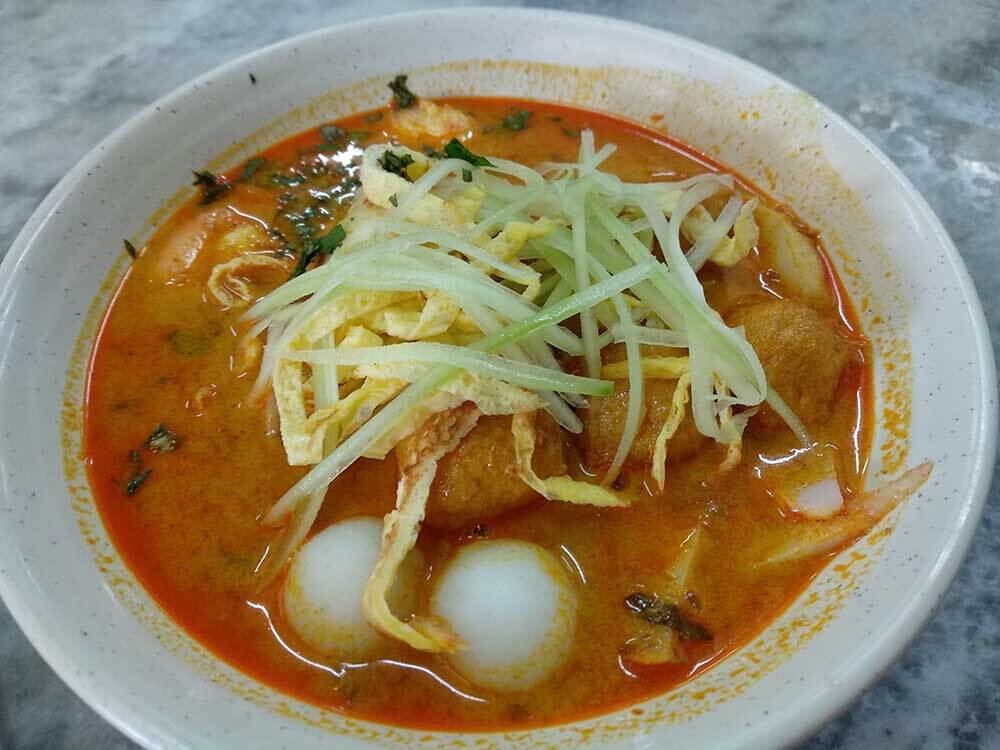
Pic by Ming Lee from Flyerism
Laksa is a popular street food commonly found in South East Asia. It’s usually the local favorite, though it’s starting to gain international recognition. In 2011, Penang Asam Laksa and Singapore Curry Laksa were listed on CNN’s list of the 50 most delicious foods in the world.
The origin of Laksa is unclear, though it’s commonly believed that the word derives from Hokkien (a Chinese dialect commonly spoken in Taiwan, Malaysia, and Indonesia) term “Luak sua”, which means “dirty sand”.
This Peranakan dish typically consists of thick wheat noodles or rice vermicelli filled with toppings like Tofu, shrimps, bean sprout, and chicken or fish. There are three types of Laksa:
Curry Laksa – The soup of Curry Laksa (also known as Curry Mee) is made from coconut milk and curry paste. Curry Laksa is commonly found in Singapore, Kuala Lumpur, and Melaka. It’s sometimes referred to as Nyonya Laksa.
Asam Laksa – The broth is made from Tamarind, torch ginger flower, fish and shrimp paste. It’s commonly found in the Northern region of Malaysia, i.e. Penang, Ipoh, Perlis, Kedah, and Kuala Kangsar.
The combination: Some versions contain both coconut milk and fish. These variants can be seen in Sarawak, Kelantan, Johor, and Terengganu.
31. Ice Cream Rolls in Phuket
By Sally from Tips 4 Trips
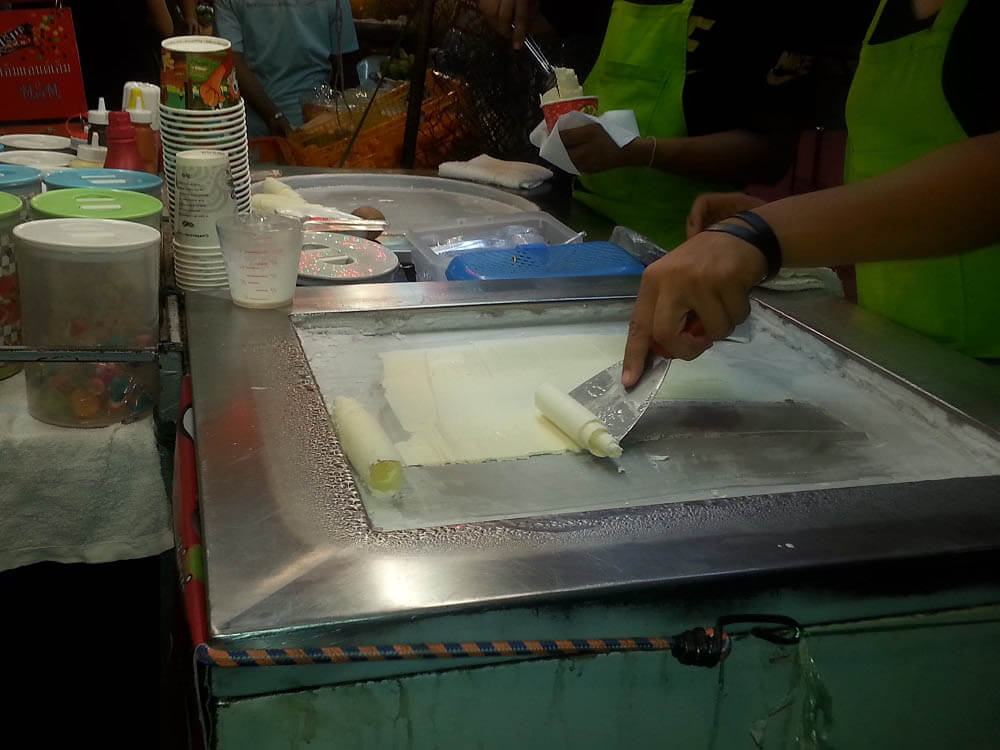
After the sun has gone down there is one street food in Phuket, Thailand that is healthy, delicious and safe to eat – the ice cream roll. Ice cream rolls are made fresh to order.
For just 80THB/$2.65USD you can choose to have yours plain or flavoured with fresh tropical fruits like watermelon, papaya, banana, mango, lychees, strawberry or coconut along with a few delicacies of Oreos or chocolate.
Watching the hypnotic and mesmerising theatre of the Phuket ice cream roll being made is one of my favourite things to do in Karon Beach, Phuket.
First a few pieces of fruit or flavourings are placed onto the freezing stainless steel plate (a bit like a BBQ cooking plate, but cold) then a cup of sweetened milk is poured over the top.
With large metal spatulas (like big paint scrapers) in each hand, the ice cream maker scoops up the now frozen milk onto the toppings and begins chopping very fast.
The ball of frozen milk and fruit is continually rolled and chopped. Spread out thin across the frozen plate. Scooped up again. Rapidly chopped. Spread. Scooped. Chopped. Until a few short minutes later the mixture is smooth.
Finally, the mixture is thinly spread; the scraper is used to roll the mixture into scrolls that are then placed upwards into a takeaway ice cream cup.
32. Sticky Mango Rice in Thailand
By Veronika from Travel Geekery
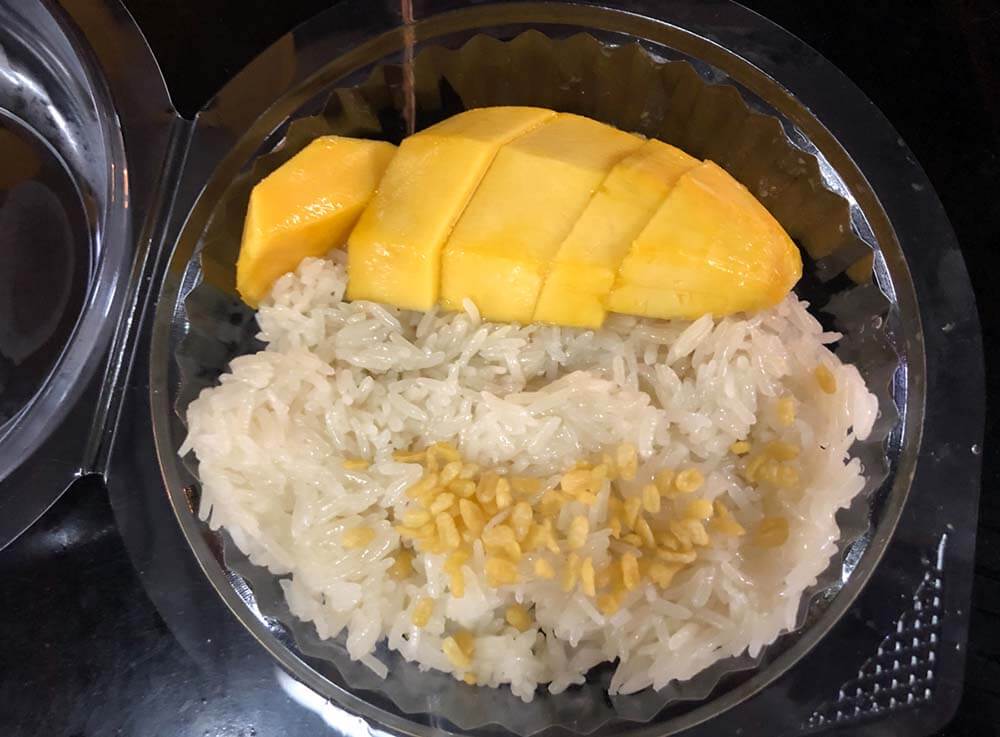
Pic by Veronika from Travel Geekery
Mango Sticky Rice (Khao niao mamuang) is one of the main food staples of Thailand. The simple dessert consists of freshly cut slices of mango and glutinous rice mixed in with coconut milk and a little bit of salt and sugar. Crispy little mung beans are often served on top.
The delicious union of the flavors of mango and coconut makes for a mouthwatering experience.
No matter if you travel just to Bangkok in Thailand or to any of the islands, you can be sure you’ll come across Mango sticky rice.
While the origin of Mango sticky rice lies in Thailand, it can be eaten all over Southeast Asia, that’s how popular it has become. It’s served as the perfect street food, but you can find a slightly more polished version in restaurants too.
You can enjoy the dessert year round, but the best time to have it is in April and May, since that’s the peak of mango season in Thailand.
Expect to pay anything from 40 baht in the most off the beaten path locations to hundreds of baht in restaurants. As a street food in tourist areas, mango sticky rice can sell for about 100 baht. Usually it’s a portion that can substitute a full meal.
33. Dadar Gulung in Indonesia
By Erin from Explore with Erin

Pic by Erin from Explore with Erin
I’m no stranger to the top Bali foods you must eat when visiting the Island of the gods in Indonesia. After 18 visits I’ve come to fall for all kinds of delicious Indonesian dishes.
But my last visit during a trip to Nusa Penida, my local guide introduced me to the most drool-worthy Balinese snack ever, Dadar gulung.
Dadar gulung is a popular traditional sweet coconut pancake. It’s a green pancake rolled up nice and tight and the inside is filled with grated coconut and palm sugar. It gets its green color from pandan leaves.
This is quite possibly the softest, sweetest, deliciousness I’ve ever come across. I’d eat the whole bag if they’d let me and it would cost as little as $1. I couldn’t stop at one and I still dream about it back home in Australia.
The only problem is they usually sell out earlier on when all the guides visit the stalls before picking up their guests for the day. So get in early.
34. Kii-Katsuura Fish Market in Japan
By Martina Grossi from The Global Curious
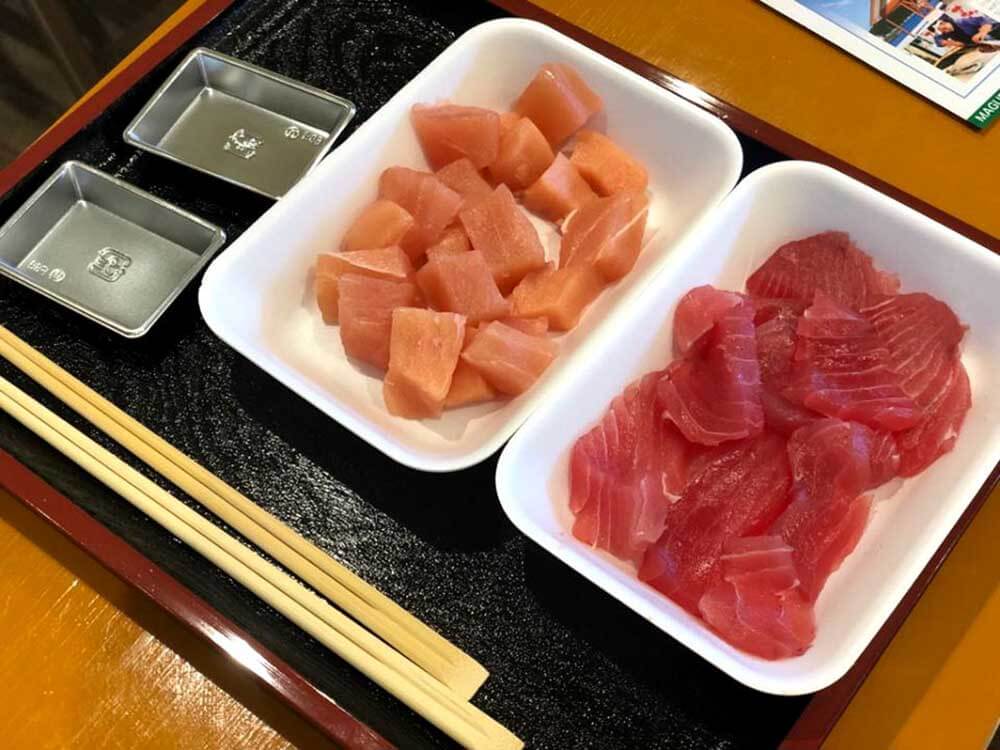
Pic by Martina from The Global Curious
If you are in any way enthusiastic about Japan, you’d know about Tokyo’s ultra-famous fish market and its daily auction.
But, what if you could experience something similar in an authentic little-known fishing village which is, actually, THE most important tuna market in the whole country?
Kii-Katsuura is a sleepy onsen town located on the Wakayama Prefecture -a region mostly recognized as Japan’s spiritual center- and although you may have not heard of it, its vicinity with the Nachi Falls makes it a place to hang out if you are exploring the Kumano Kodo Trail.
So why is the Katsuura Fish Market so special?
For starters, the market itself it’s beautiful, quite small and set near the sea. Also, you can rest your feet in hot spring fountains scattered across the coastline -fun!
If you get to the 7 am auction you’ll see some big badass tuna fish of up to 150 kg lined up on the floor, plus many small ‘scenes’ going on at the same time -from eager buyers sinking metal hooks in the fish to check its quality to men reciting offers over the speaker, and folks rapidly taking notes on small charcoal boards.
The best part of the lively setting comes later though, once the fish it’s on the market’s counters waiting to indulge a sashimi’s lover palate! It’s fresh, cheap, crisp, simple, soft…a real sashimi dream come true.
35. Turon in Philippines
By Jing from Finding Jing
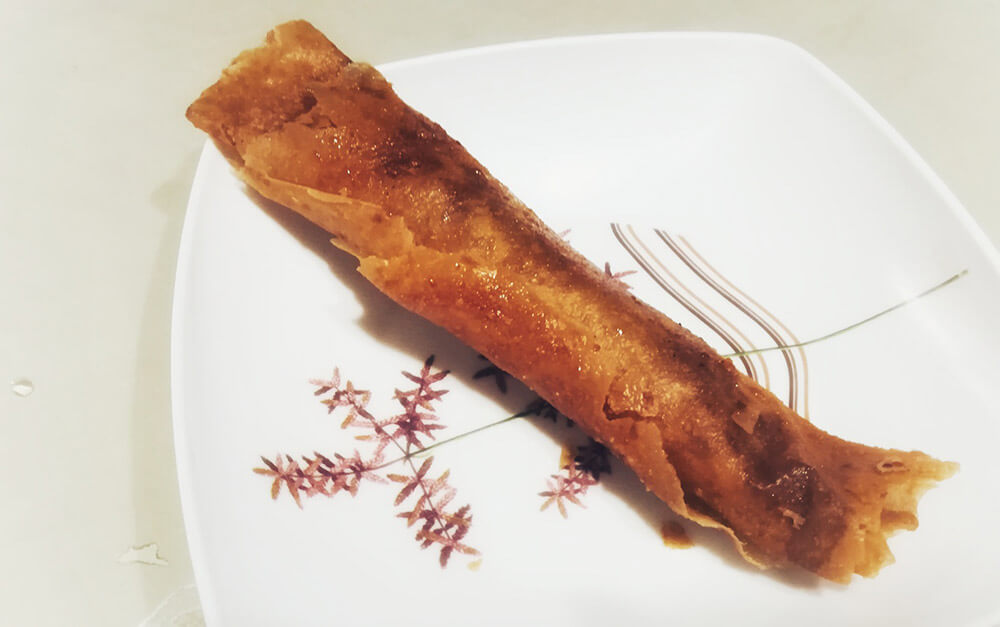
Pic by Jing from Finding Jing
Ask any Filipino about their favorite street food and turon will definitely be at the top of their list. This best-seller snack is made of crosswise-sliced bananas rolled in spring roll wrapper, coated in brown sugar, then deep fried to golden brown.
Saba is the banana variety used for turon. Though saba can be eaten raw, it is usually added as ingredients for cooked Filipino meals.
Turon is best eaten while hot so you get to taste the sweet banana while the wrapper is still crunchy. The classic version of turon is made of banana only while the special version has strips of langka (jackfruit) filling.
You will find turon sold by street cart vendors, carinderias or small food stalls with seating area along the roadside, or by roaming vendors in bicycles with sidecar. Price is Php 15-20 per piece or 0.30 – 0.40 USD.
This all-time favorite snack food is often sold with banana cue (deep fried bananas coated in sugar, skewered in bamboo sticks), camote cue (deep fried sweet potato dipped in sugar, sold in bamboo sticks) and maruya (banana fritter). If you want a bout of banana abundance in the Philippines, you might as well try these, too.
36. Gua Bao in Taiwan
By Wendy from The Nomadic Vegan
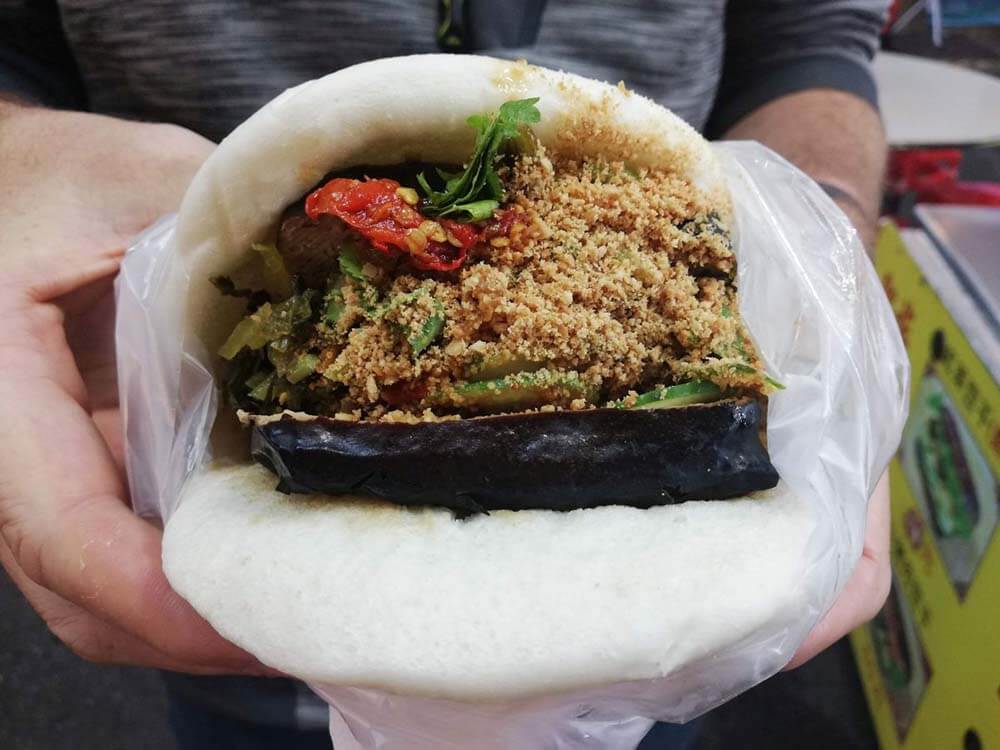
Pic by Wendy from The Nomadic Vegan
The base of gua bao is the baozi, which is a steamed bun that’s a popular street food in China as well as in Taiwan. What makes gua bao different from regular baozi is that the buns are sliced open on one side and fillings are stuffed inside like a sandwich.
Gua bao have become popular around the world in the past few years, and you may come across them being sold in other countries as a “Taiwanese hamburger”.
They are also sometimes called a “pork belly bun”, since that’s the traditional filling. But nowadays you can find more creative gua bao vendors with many other options for fillings. So if you don’t eat pork, don’t worry, you can still enjoy this delicious and filling snack in Taiwan.
At the Ita Thao night market on Sun Moon Lake, I even came across a stall selling vegan gua bao! This particular stall sold two different local specialties, gua bao and dou gan.
The latter is a thick slab of marinated tofu which, like gua bao, is sliced open and stuffed with various fillings. This sounded yummy but messy, so I chose the best of both worlds by ordering a stuffed dou gan inside a gua bao!
Of all the tasty treats I tried at the Ita Thao market, this one was the best. So good, in fact, that I went back the next day for another one.
37. Kabab in old Delhi
By Sapna from My Simple Sojourn
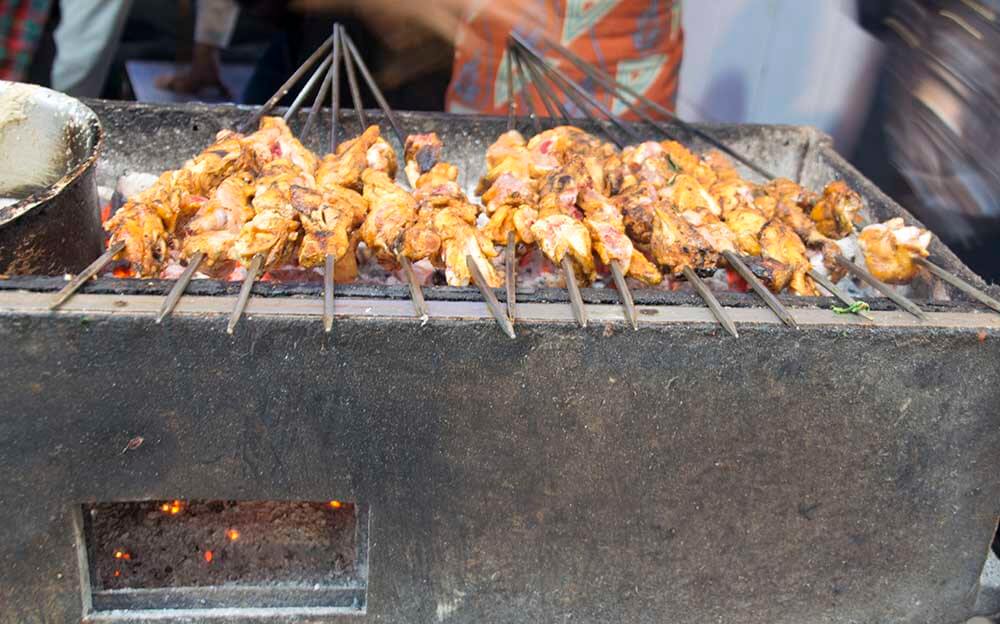
Pic by Sapna from My Simple Sojourn
Delhi has a rich food culture because it was once the capital of the Mughal Empire. Secondly, lots of people made it their home at the time of Independence of India and they influenced it.
If you are a non-vegetarian than the area near Jama Masjid is like a gold mine. There are rows of big and small shops selling several meat preparations from morning till night. The street of food in old Delhi is mouth-watering.
Kababs are one of my favorite street foods here. They are easy to eat when you don’t have sitting arrangements.
There are two types of popular Kababs, one is “Seekh kabab” and another is “Boti kabab”. Seekh kababs are made of minced meat, which is mixed with spices and grilled on skewers.
Boti kababs are chunks of meat, which are grilled on skewers after marinating with curd, ginger-garlic, and spices. These kababs are served with Rumali roti (Which is thin like a handkerchief), mint chutney and raw onion rings.
These kababs are mostly available in chicken and lamb meat, sometimes you get these in buffalo meat also. There are several shops but the most famous places for kabab in old Delhi are Qureshi kabab, Aslam chicken and Babu Bhai kabab.
38. Yakitori in Japan
By Tanja from Ryokou Girl
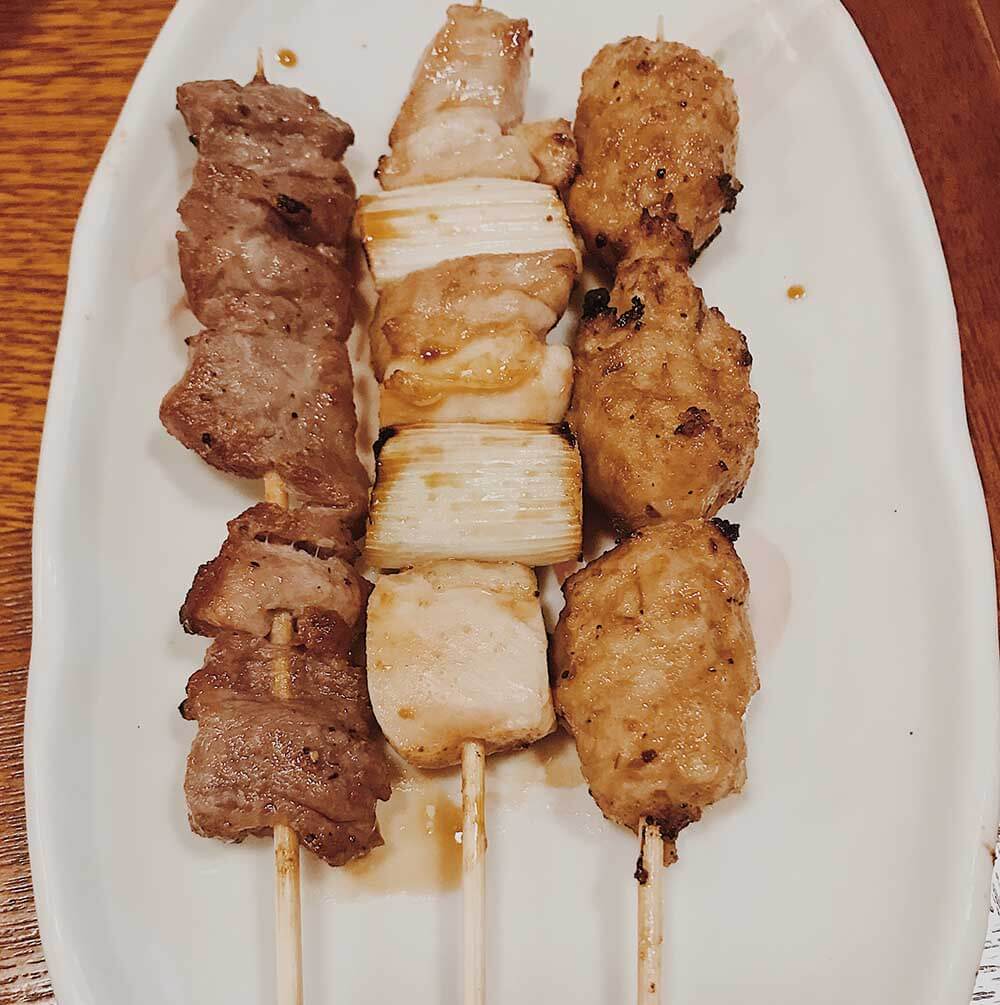
Pic by Tanja from Ryokou Girl
If you think of Japanese street food, then yakitori is often the first thing that comes to mind. Whilst simply put, yakitori are grilled chicken skewers, there are actually so many varieties to try that you can go to a yakitori restaurant and try a different kind of skewer for each course.
Yakitori is often associated with street vendors in Japan, particularly during matsuri (festival) season in the summer, when Japanese people dress in yukata (summer kimono) and attend festivals to watch fireworks and eat delicious street food.
What makes yakitori so delicious is a combination of different factors, from the way that it is grilled over Japanese charcoal, to the seasoning used on the chicken, and the different cuts of meat.
For example, it’s possible to eat yakitori made from chicken thigh, skin, or even innards such as liver or heart depending on how adventurous you are.
Yakitori is not expensive at all to try and you’ll see it on most izakaya menus for around 100 yen per skewer. If you can’t make it to a Japanese festival to try yakitori then my recommendation would be to visit Torikizoku, a popular and inexpensive chain of yakitori restaurants with branches all over Tokyo that have English menus so you know exactly what kind of cut of meat you are ordering!
39. Sukhothai Noodles in Thailand
By Josh Wilson from Peanuts or Pretzels Travel
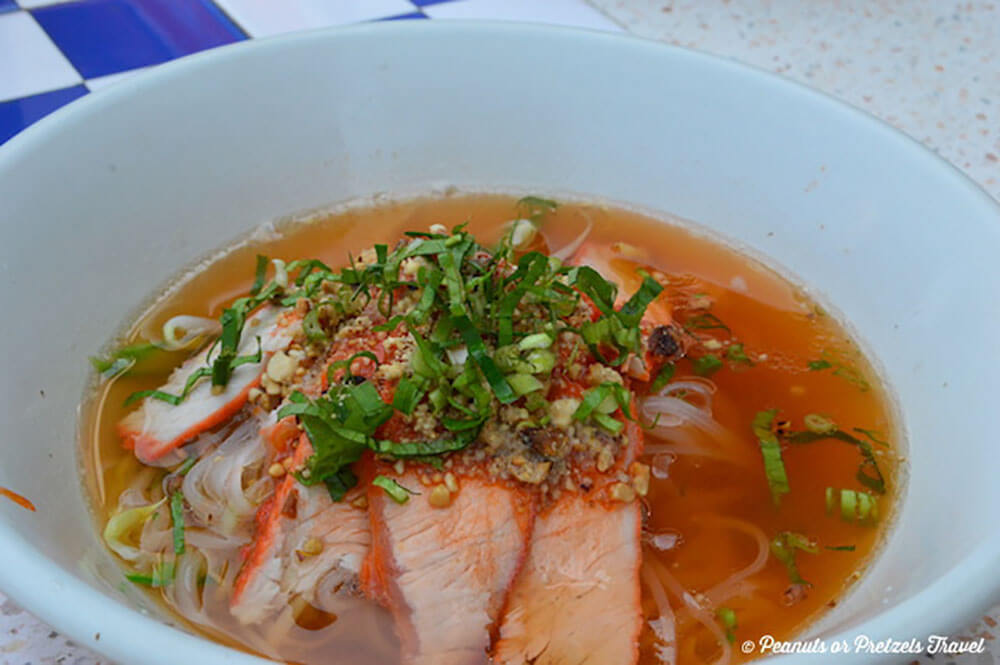
Pic by Josh Wilson from Peanuts or Pretzels Travel
While traveling in Thailand, most visitors rave about the food. For us, the most memorable dish that we had in all of Thailand was in Sukhothai — and that was their famous Sukhothai Noodles!
A little bit off the beaten trail in Thailand, Sukhothai is one of the former ancient capitals in the region and its temples are older than Ayutthaya. Sometimes called Thailand’s Angkor Wat, this town is surprisingly not on the radar of mainstream travelers to Thailand.
In fact, we found the town much more relaxed and enjoyable because of this. But Sukhothai is also home to some of the most amazing street-side noodles we found in Thailand.
Perfectly cooked, Sukhothai noodles are thin rice noodles which are placed in a bowl and then surrounded by a light yet flavorful broth with just a hint of sweetness.
Then the dish is garnished typically with a few bits of sliced pork, spring onions, bean sprouts, crushed peanuts, garlic and cilantro.
We preferred to also add a dash of spice to it too. The great thing is that this savory dish cost less than the equivalent of $2.
Since it was such a tasty and inexpensive dish, we found ourselves eating it every day during our visit (sometimes multiples times per day) from all the different vendors around town.
We just couldn’t get enough Sukhothai noodles! Even though you may find them in other towns in Thailand, we found the original noodles in Sukhothai to taste far better than anywhere else.
40. Lort cha in Cambodia
By Emily from Wander-Lush
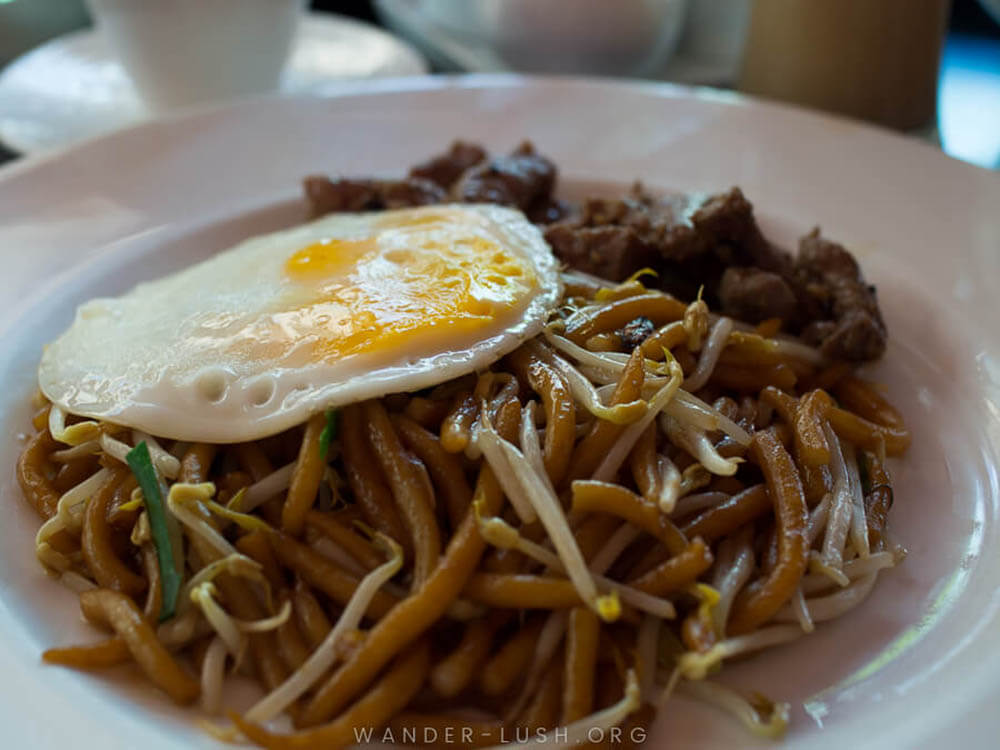
Pic by Emily from Wander-Lush
Lort cha (stir-fried noodles) is a culinary staple in Cambodia and a must-try street food in Asia. This simple yet tasty dish is made from lort – short, fat rice noodles that you see being sold fresh at marketplaces around the country.
Lort cha is quick to prepare, so street vendors make it to order. The noodles are thrown into a hot pan and stir-fried with bean sprouts, chopped Chinese broccoli, chives, and green onions.
Soy sauce, chilli, Oyster sauce and other delicious condiments of unknown origin are then applied liberally from squeeze bottles.
The core dish is vegetarian, but chicken, pork or beef might be added on request, or more typically served on the side. A few more tosses of the wok, and the saucy noodles are transferred onto a melamine plate or into a takeaway container.
It’s not lort cha without a fried egg on top – the hallmark of a good version is when the egg yolk is just runny enough to stir through the noodles.
Because of their size and shape, lort noodles have a slightly chewy texture. The dish is fresh, easy, and budget-friendly – perfect for a quick bite.
Lort cha is typically eaten for breakfast or lunch. In Phnom Penh, you can find basic versions being served at every marketplace in the city, or ‘elevated’ lort cha at any Khmer restaurant.
41. Pho Cuon in Hanoi, Vietnam
By Emily from Wander-Lush
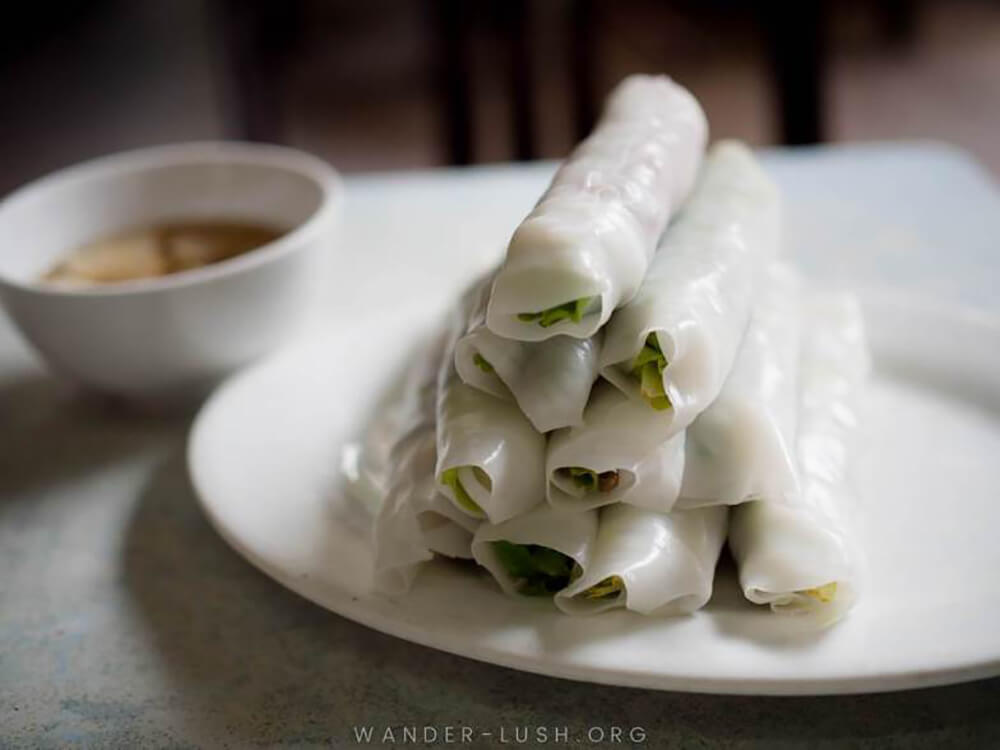
Pic by By Emily from Wander-Lush
Good street food embodies a particular place and culture in its flavours and textures. The northern Vietnamese dish phở cuốn epitomises this perfectly. Pho cuon is quintessentially Hanoian.
More specifically, it’s native to the lakeside neighbourhood of Truc Bach, and can only really be found in the handful of street food eateries that specialise in the dish, which are all centred around one intersection.
Legend has it that the recipe for pho cuon was a happy accident. When a restaurateur in Ngu Xa village (now Truc Bach, one of the city’s oldest areas) ran out of broth for pho soup, she decided to use square sheets of un-cut rice noodles and left-over soup ingredients to devise a different version of the Vietnamese favourite. The result: a simple combination of beef, lettuce and coriander rolled in silken pho sheets.
They’re a bit like fresh rice paper rolls but because of the noodle wrapper, pho cuon is super soft and delicate.
A portion at a restaurant in Truc Bach consists of half a dozen rolls at a minimum, always served with nuoc cham (fish sauce flavoured with rice vinegar, garlic and chilli) on the side.
Truc Bach chefs also serve other riffs on pho, including pho chien phong – the same square rice noodle sheets, this time deep fried until puffy then served with beef and greens smothered in a thick, sweet and salty sauce.
42. Hainanese chicken rice balls in Melaka, Malaysia
By Alana from Family Bites Travel
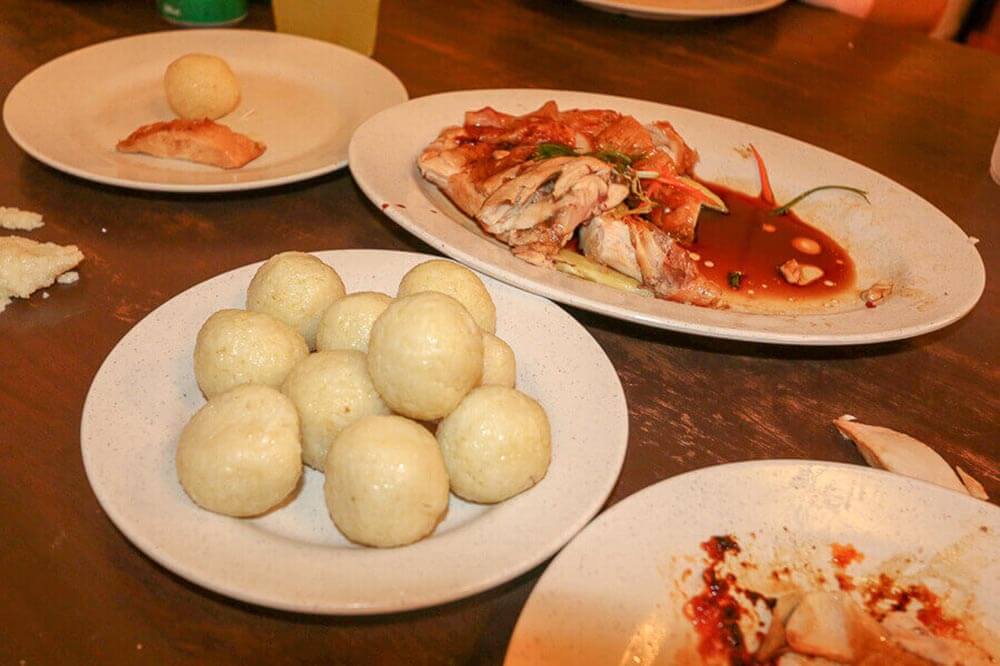
Pic by Alana from Family Bites Travel
A specific version of Hainanese chicken rice balls is famous in Melaka, Malaysia.
The chicken is poached in master stock. The rice is cooked in the poached chicken master stock and shaped into ping-pong sized balls. The rice balls are so flavorsome you can eat them without anything else.
The complete dish is poached chicken served with rice balls and garlic-chili sauce. The eating experience goes to astronomical levels of yum!
Why is the rice shaped into a ball? The theory goes that back in the day, it made transportation easier, and it kept the rice warm for longer. Whatever the reason, eating a common food in a new way is fun, and this is the tastiest rice you can try.
There are countless stalls in Melaka to buy chicken rice balls. Some of these have been selling these spheres rice balls of deliciousness for many generations.
The most famous (and most touristy) are arguably Hoe Kee and Chung Wah. You need to be prepared to wait as there will be lines! A more affordable and less touristy option is Huang Chang Chicken Rice.
Make sure to try this delicious street food when you visit Melaka!
43. Cambodian Sticky Rice
By Emma from Journey of a Nomadic Family
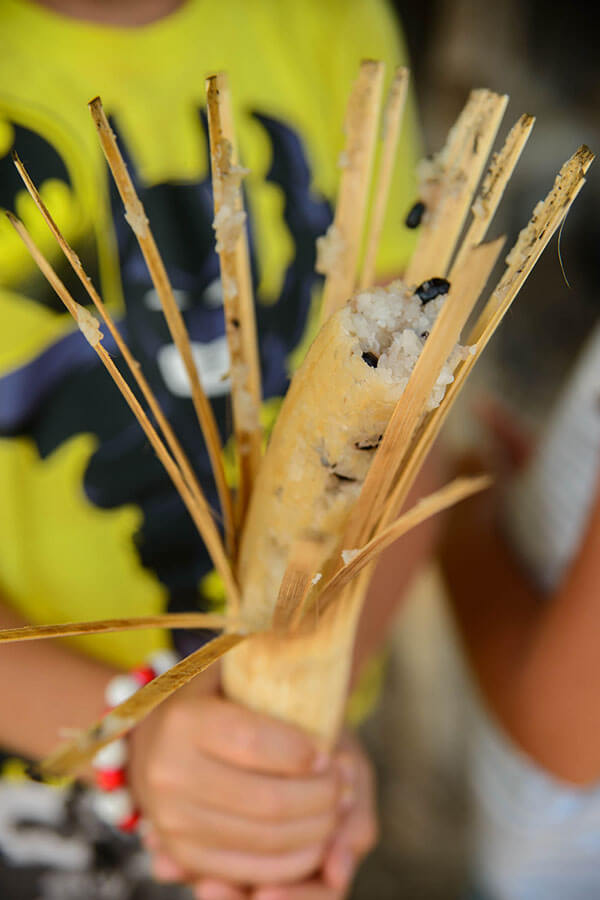
Pic by Emma from Journey of a Nomadic Family
Whilst we were staying in Siem Reap we took an off the beaten tour to the enormous and swelling lake of Tonle Sap and a local market. I think everyone has heard of the delectable sugar cane juice that is pressed there but this is not what caught our attention on that day.
As we were driving back into Siem Reap, small wooden stalls lined the near side road, each with a small trickle of smoke escaping from beside them. I was interested to learn more so our guide let us stop.
Each of these wooden shacks was supervised by a lady, using a fan to control the smoke and gloved hands to turn what looked like tubes of bamboo over smouldering hot coals.
The bamboo was home to a cooked rice mixed with coconut cream and tiny black beans. For less than 50c we were given one which is peeled in sections, revealing what looks like a banana, only it’s steaming hot.
If you see one of these stalls by the side of the road, don’t be afraid to stop. The Cambodian people might not always speak your language but they greet you with smiles and for less than $1, you can contribute directly to their local economy.
This rice was piping hot, soft and moist, full of sweet, coconut flavour and remarkably easy to eat. It’s a must if you’re travelling Cambodia, especially with kids.
44. River Weed in Laos
By Brittany from The Rolling Pack
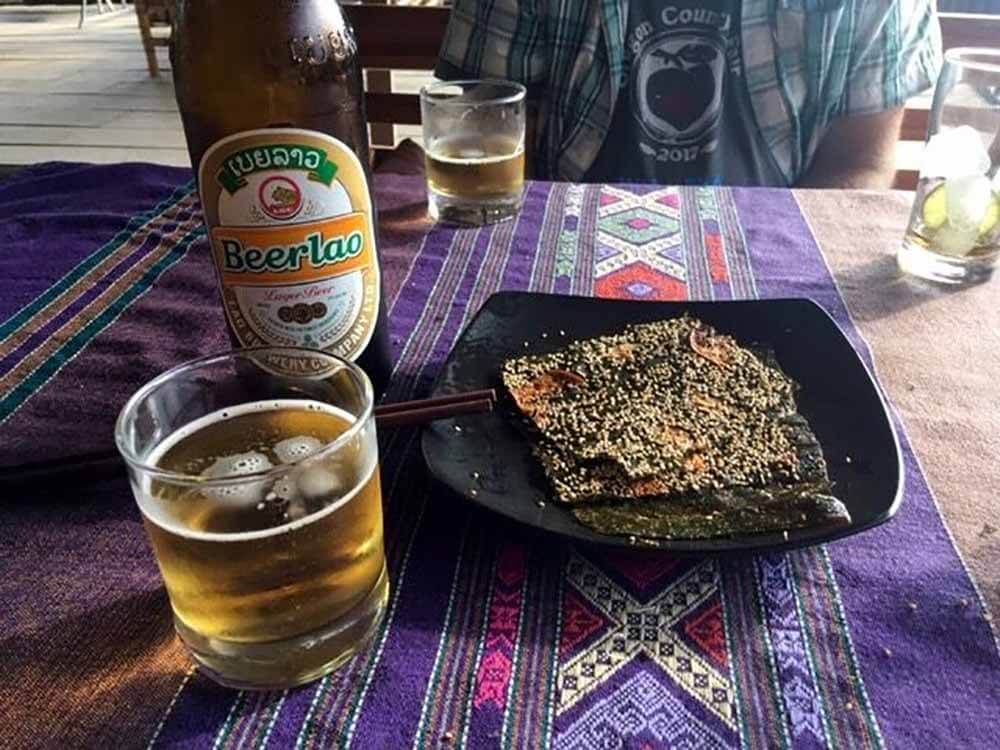
Pic by Brittany from The Rolling Pack
Laos is home to one of my favorite street food snacks of all time, river weed! With a name like river weed it’s no wonder few people try this traditional Laotian food. Don’t be put off by the strange name of this dish. I promise it will exceed your expectations!
The mighty Mekong River flows down the entire length of Laos, and this is where river weed is harvested. Fishermen pull the seaweed-like plant from the depths of the river. In the next step of preparation, garlic, tomato slices, and sesame seeds are pressed into the weed, and it is placed in the sun to dry.
Once it is completely dry it is salted and lightly fried in oil and ready to eat!
The flavor of river weed is similar to dried seaweed, but far more delicious thanks to the tomato, garlic, and sesame seeds which give this dish tons of flavor! Pair this with a Beer Lao and you’re in for a real treat.
45. Isso Vadai in Srilanka
By Rai from A Rai of Light
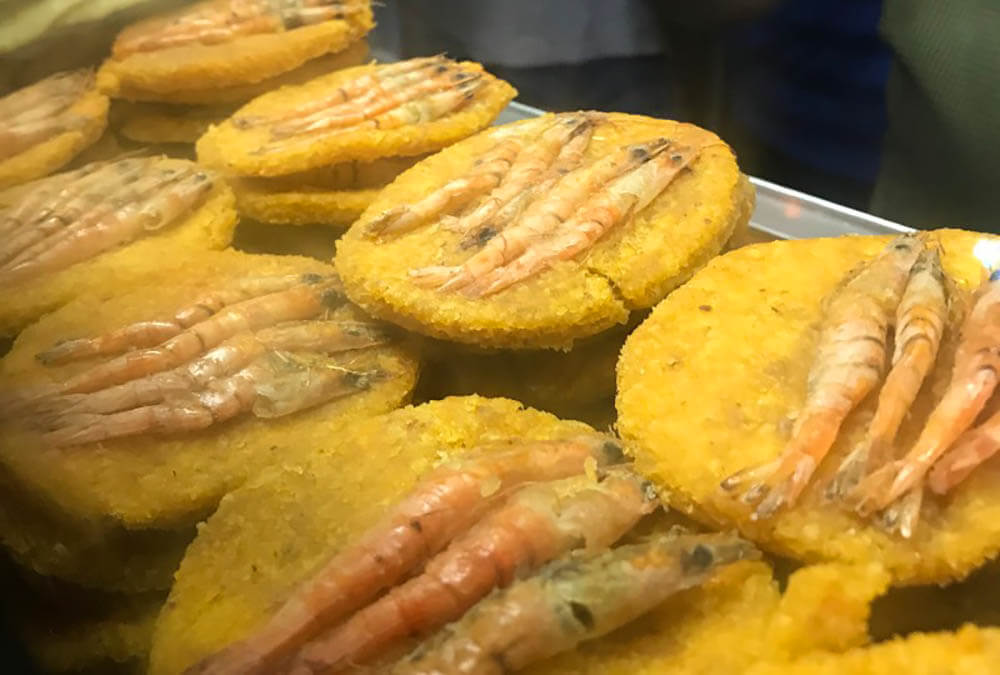
Pic by Rai from A Rai of Light
Asia is filled with exotic foods that you have to try as you pass through the streets. One such favourite is the isso vadai found in Sri Lanka. You can often find a vadai cart in almost every town, usually near the train station or bars. They are also a favourite of the locals as their go to after-work snack.
These spicy lentils cakes are deep fried with three tiny whole shrimp (with heads intact) on top, reminding me a lot of the street food in Egypt. Even though it may not be the most healthiest nor the most hygienic of foods, they are crunchy, delicious, and cheap.
The price will depend on its size and type, but they usually go for around Rs. 50 in most places. These cakes are not so great to look at, but are strangely addictive and something you have to try.
Related: Guest House in Aswan called Bob Marley
46. Pani Puri in the UAE
By Lieze from Glitter Rebel
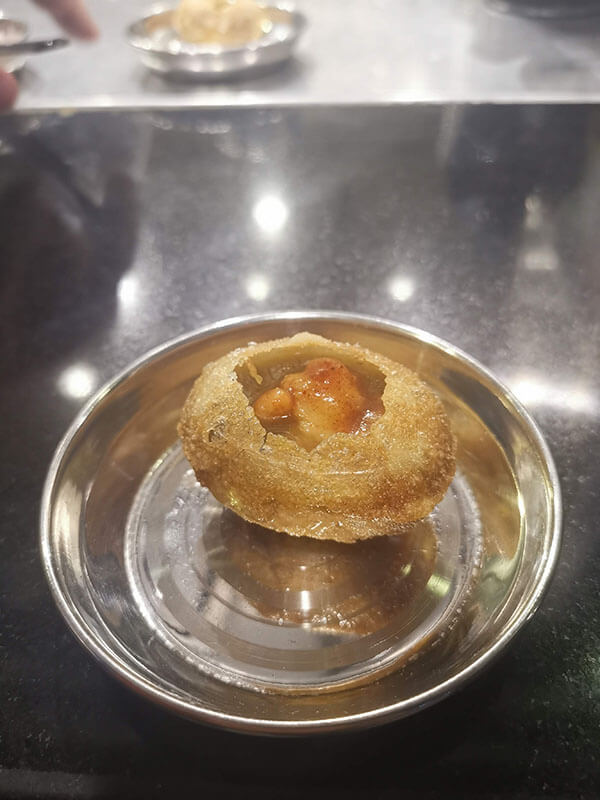
Pic by Lieze from Glitter Rebel
“Little wet balls” that is how one of my friends describes Pani Puri whenever we go out for our weekly hit. These little wet balls are incredibly addictive – hard-shelled (a bit like tacos) and filled with chickpea soup, a bit of mango chutney and chickpeas, Pani Puri is an absolute explosion of flavour in your mouth.
Dubai is not known for its street food – I don’t even think local Emiratis have anything that would compare to street food – but the Indian and Pakistani labourers and expats brought their favourite snacks and chaat with them. Now, on almost every street you will find a little Indian café where you can buy a 1 Dirham chai (milk tea) and a cheap portion of Pani Puri.
Want a more street food vibe? No problem – most of these cafes have little windows where you can order your chai and Pani Puri on the go. No need to go in!
You might struggle as they don’t necessarily speak English but you can order a chai and a portion of Pani Puri by asking for ‘’Ek Chai aur ek bhaag Paani Puuri’’
Pani Puri portions normally consist of 8 Pani Puris. You eat these little balls as the cook makes them. He will hand you a small little plate on which he puts the Pani Puris. You put the balls in your mouth in one go and bite down on them.
At the end of your order you will receive a dry pani puri. This hard-shelled ball is filled with vermicelli’s or potato and serves as a pallet cleanser.
47. Danzai noodle in Tainan, Taiwan
By Katy from Photospired
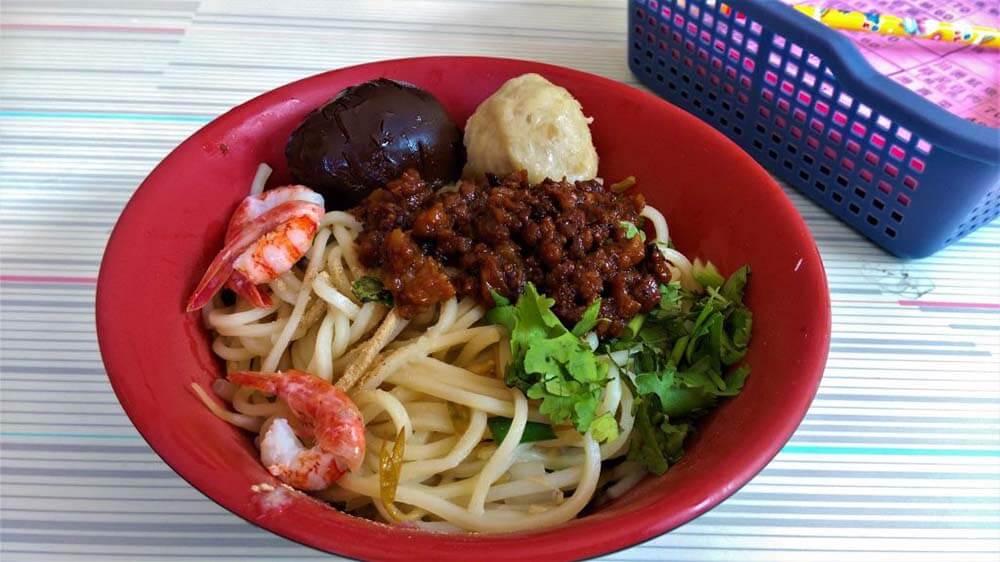
Pic by Katy from Photospired
If there is one dish synonymous with Tainan, it is the danzai noodle. It is a simple dish consisting of oil noodles, shrimp, marinated egg, and minced pork.
The sweetness of the shrimp strikes the perfect balance with the savoury of the minced pork. Served both dry and in shrimp-based broth, it satisfies the craving while leaving you wanting more.
The dish has an interesting story too. In the late 1800s, struggling to survive during the rough months that made seafaring impossible, a fisherman named Taro Hung began to carry the noodle dish over his shoulder poles and selling it on the streets of Tainan. The dish became an instant hit and soon Hung was able to make a living selling the noodles.
Because of its humble origin, Hung’s noodle stand became known as Du Xiao Yue, literally translated as “to bear over the bad months”. Now in the fourth generation, Du Xiao Yue’s danzai noodle is the ultimate street food in Tainan and a must-try when you visit the city.
48. Steamed taro cake in Taiwan
By Katy from Photospired
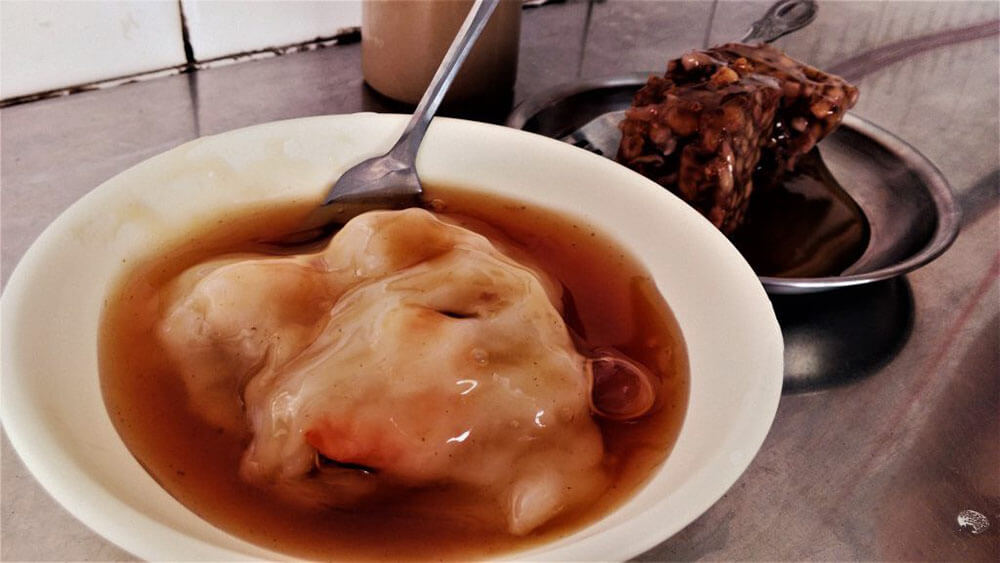
Pic by Katy from Photospired
Served as a snack yet densely packed with taro goodness, the steamed taro cake is a classic street food in Tainan. Quite unbeknownst to people outside of Taiwan, taro is a popular plant used in a variety of Taiwanese dishes for its mild, sweet flavour.
Tainan-ians love sweet flavours but also cannot resist a touch of savoury. The result? A dish that is made of chunky taro bits and minced pork. Steamed and garnished with cilantro, it is the best of both worlds!
The taro breaks apart easily for a fluffy texture, while the minced pork adds a hint of soy sauce and flavour.
In the historic city of Tainan, every food dish has a fascinating tale— even the most humble street food. The steamed taro cake originated from a play on words.
To pray for “peace through the years”, the taro is finely chopped into “pieces”. Even today, the dish can be found used in the locals’ worship and offerings to the hundreds of temples around the city. When visiting Tainan, be on the lookout for street vendors that serve this simple delicacy. It can’t be missed!
49. Gado Gado in Bali
By Sophie from Baby Toddler and Kids
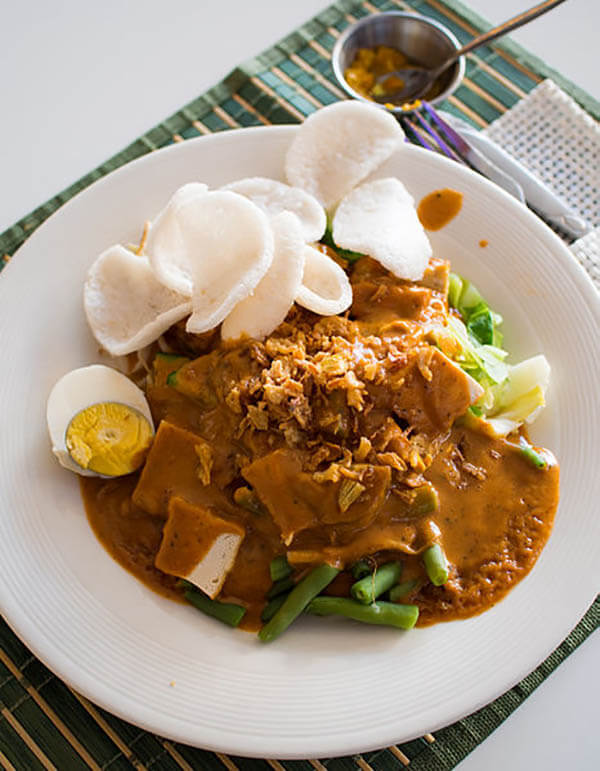
Pic by Takeaway on Wiki Commons CC BY-SA 4.0
I love pretty much any Asian street food but one of my all time favourites has to be Gado Gado in Bali! Before I first visited the island, my partner kept telling me I should try it and honestly I thought he was talking about some kind of dessert (like the French “gateaux”) but I couldn’t have been more wrong.
Gado Gado is actually a super healthy and delicious Indonesian salad dish and has actually been named one of the 5 national dishes of Indonesia!
The dish consists of lightly blanched or steamed vegetables that still have a lovely crunch to them all mixed together with fried tofu and tempeh (hence the name, which translates as mix-mix).
The dish is then traditionally topped with a boiled egg, although in some areas you’ll find they use a fried egg instead. The best part? It’s then smothered in a traditional and mouth watering peanut sauce, usually with a little kick to it.
Every time I visit Bali I always like to hunt for the best gado gado I can’t go past one of the street vendors pushing a gado gado cart without having a taste!
50. Rujak in Southeast Asia
By Kaisa from Glam Granola Travel
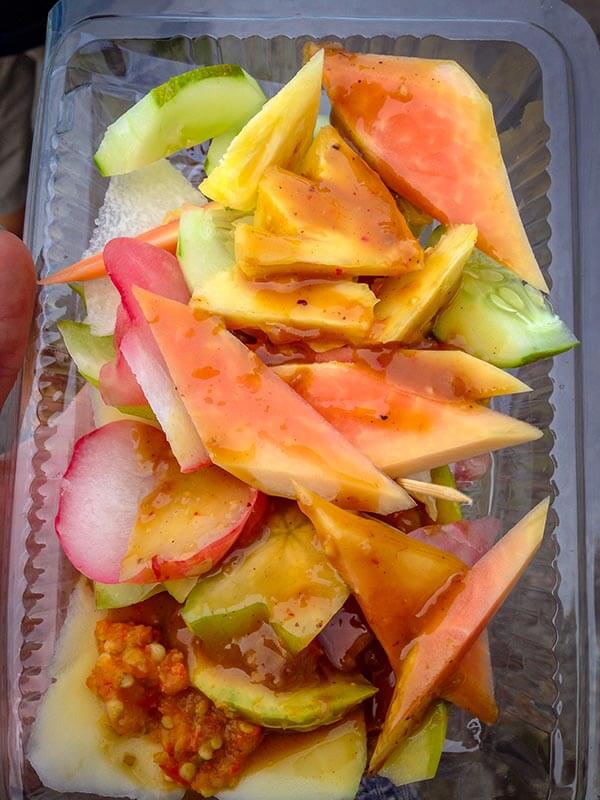
Rujak is one of those Southeast Asian street foods you’ve never heard of, but will become completely addicted to.
Simultaneously savory, refreshing, spicy, and sweet, it ended up being one of my absolutely favorite snacks when backpacking in Indonesia.
There are variations of Rujak across Indonesia, Singapore, and Malaysia. Essentially, it is a fruit salad with spicy dressing and often some sort of peanut element.
While I can’t say I ever had two identical dishes, the fruits I remember enjoying most would have to be fresh mango, jicama, ripe pomelo, starfruit, and juicy pineapple. Some would have other less sweet additions, like cucumber or potato.
Sometimes, there would also be an absolutely delicious peanut sauce on the side or powdered chilis for extra kick. The common element in all Rujak is the spicy palm sugar peanut dressing.
As a Southeast Asian street food, obviously a helping of Rujak is not going to break the bank. I remember it being around $1 USD, and moderately popular so it wasn’t difficult to find.
I honestly never expected to love it as much as I did, but was so pleasantly surprised by the unique melody of flavors—I couldn’t get enough!”
51. Khao Soi in Chiang Mai, Thailand
By Steffi from Beach Bum Adventure
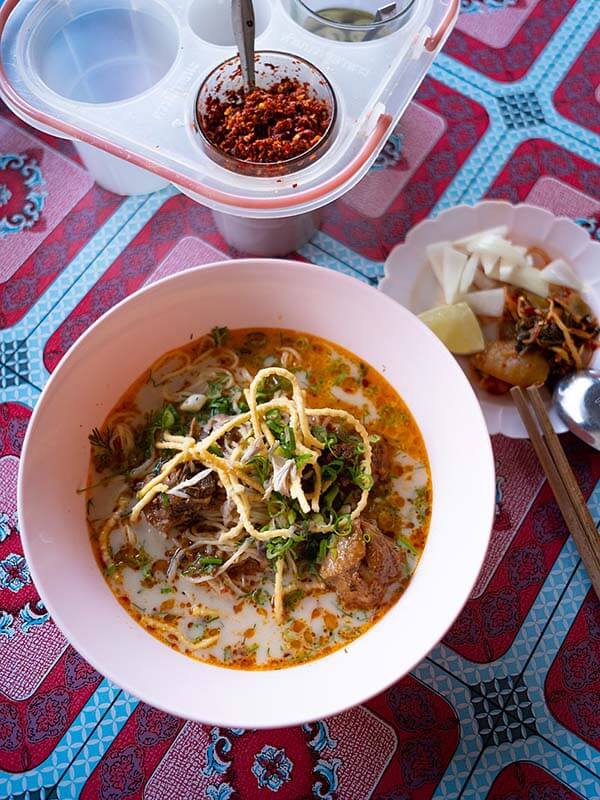
Pic by Takeaway on Wiki Commons CC BY-SA 4.0
A lot of tourists know that when they come to Thailand, they are going to experience amazing Thai food. But what many people don’t realise is Thailand’s huge range of regional dishes.
My favourite has it’s origin in Chiang Mai, in the North of Thailand. It is a yellow, creamy and slightly spicy soup, with egg noodles, a chicken drumstick and (the best part) crispy fried noodles sprinkled on top.
Known as “khao soi” (it has many different spelling variations), you can find it in the street food markets in Chiang Mai.
Be prepared for it to be spicy if it’s served in a more local area, if you request in a more tourist area they will probably tone down the spiciness of it! If you are vegetarian you can ask for it minus the chicken drumstick if you don’t mind that it may have been cooked together.
52. Durian in Malaysia
By Iuliya of Doing Life with Iuliya
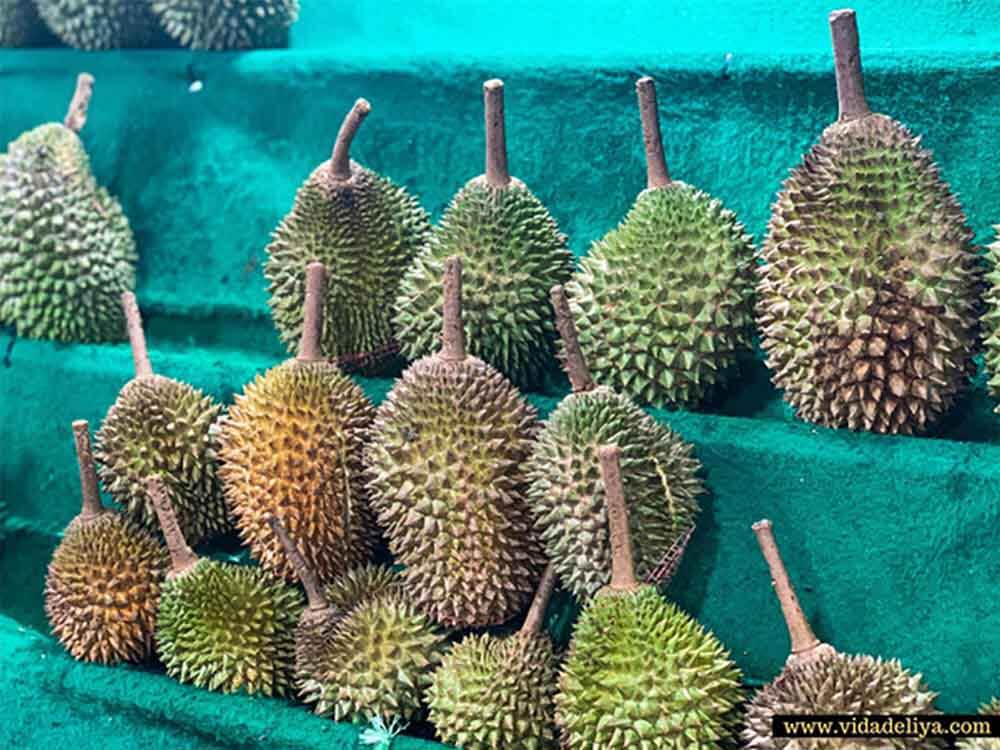
Pic by Iuliya of Doing Life with Iuliya
Durian is probably up there with the likes of Iceland’s fermented shark as one of the most divisive food items you will find.
I have heard, read and watched (in amusement) at the sheer disbelief and horror of those who try durian for the first time.
It apparently smells sweaty socks left unwashed for months and leaves you with a breath that Anthony Bourdain once described “as if you’ve been french kissing your dead grandmother.”
Honestly, I’ve never understood any of the florid exaggerations. Durian – that thorny, green fruit with deliciously milky soft flesh – has always been a love of mine.
It smells fragrant and tastes heavenly – provided you opt for Musang King (it’s a type of durian)! Yes, for those who love durian, there are indeed many different grades of durian and you definitely pay for the taste.
For the uninitiated, I would still suggest going for Musang King, to give yourself the best chance of “loving” durian too. Just try one seed.
You can easily find durian anywhere in Malaysia; it’s practically a national fruit. And there are even options to go for durian buffet: the stall sells hundreds of durians only (and fresh coconut juice).
There will be a humble table and many chairs for you to seat on, alongside a massive open crate where the husks of durians and seeds left by earlier patrons reside. An experience you might want to skip if you’re not too keen on the smell!
53. Bhelpuri in India
By Sarah
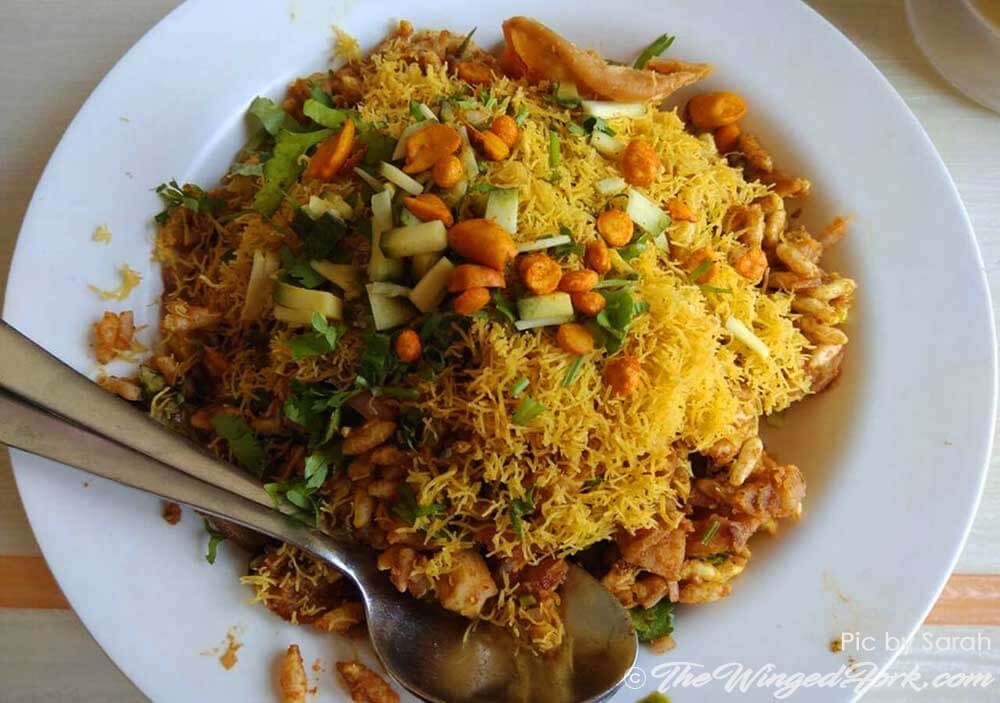
Bhelpuri is a famous street food all across India. Vendors carrying baskets on their heads roam around the streets selling this puffed rice dish.
Puffed rice is mixed with chopped onions, tomatoes, boiled potatoes, roasted peanuts, coriander leaves, and some sev. These are then filled in a cone made of old newspaper or magazine pages. It’s then tossed together with lime juice and a sweet tamarind sauce or a spicy green chutney depending on what you ask for.
A few crispy puris are broken into pieces and thrown into the mix, and a few more added on top for to use as spoons. Of course, you eat them up once you’re done.
Bhel or bhelpuri costs a measly INR 15 to 25 and is the perfect snack at any time of the day. You get bhel puri in restaurants too, but it costs a bit more. If I’m going to eat in a restaurant, I love the bhel puri at Elco Pani Puri Center in Mumbai.
54. Nasi Kundar in Malaysia
By Priyanka from On My Canvas
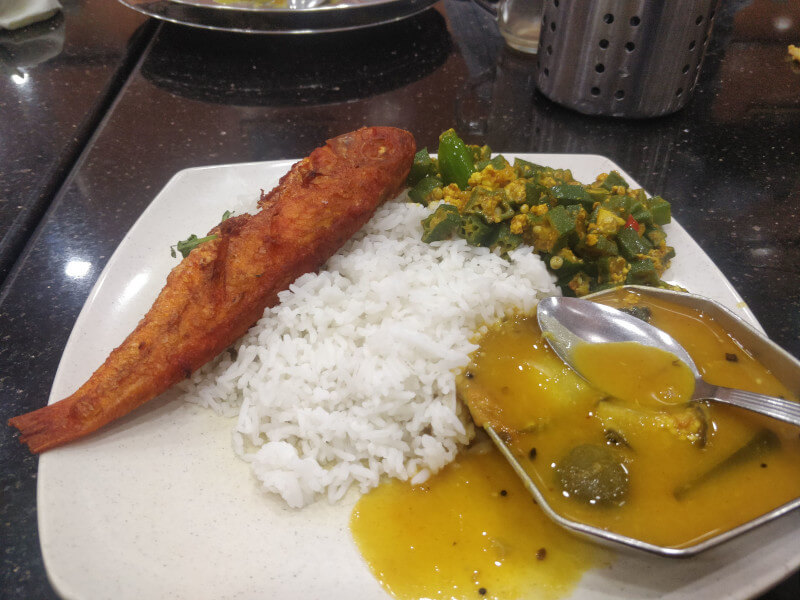
Pic by Priyanka from On My Canvas
Nasi Kandar is one of the many preparations in Malaysia that kept me over-stuffed most of the time. When I saw stalls of rice, sambar, grilled fish, sweet and sour fried fish, fried okra, and other vegetables together eaten with dal and rice, I thought that I was back in India.
But this rice meal, that Malaysians told me is known as Nasi Kandar, was different from the Indian thali in many ways. Nasi Kandar had more varieties of vegetables, many preparations of fish were a must-have with the rice, and even okra had a different flavor there as compared to anything I have eaten in India.
Nasi Kandar’s name is inspired by stories of Indians who migrated to Malaysia to work as laborers. These migrant Indians sold rice, known as Nasi in Malaysian, from bamboo baskets hung over their shoulders, known has kandha in Hindi, to workers.
You would even see Penang’s street signs showcasing Nasi Kandar’s origin. As I searched for street food in Penang, mostly I was distracted by Nasi Kandar and couldn’t eat the other food options.
You can easily find this dish in small restaurants, hawker centers, and night markets. Remember you pay per item. So a smart way to eat would be to choose one or two items and eat more of them. Well, who am I to comment for my plate was always flooded with varieties of fish, as you can see in this picture.
55. Dabeli in India
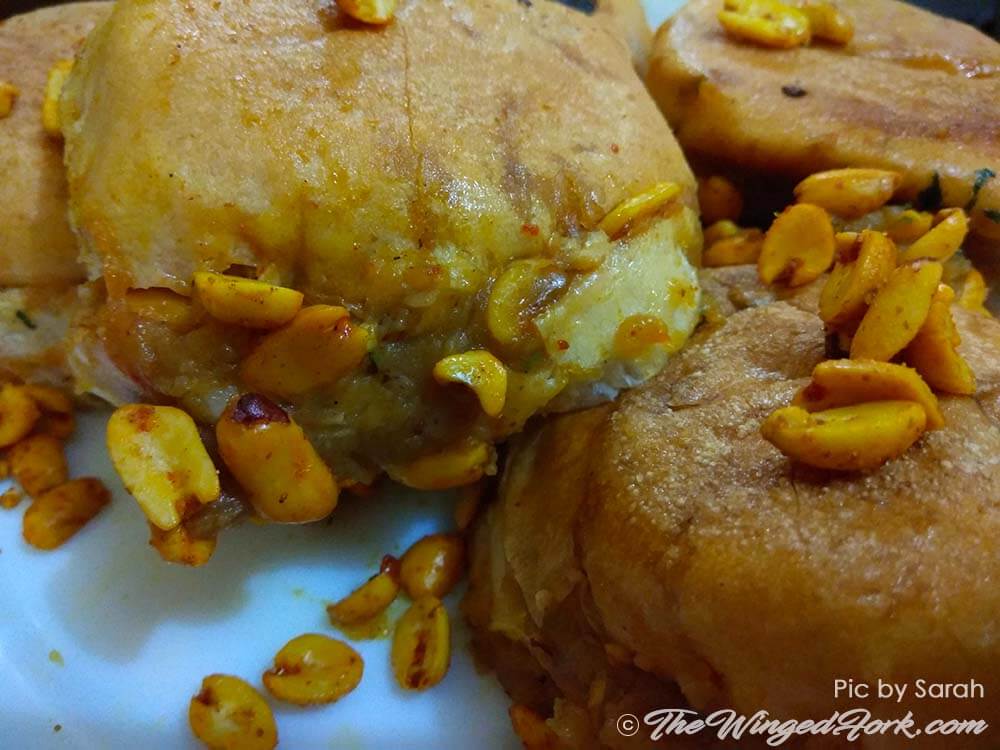
A snack that means “pressed” has different about it! The Dabeli or Kutchi Dabeli as it’s called is a Gujarati word that translates to “pressed” in English.
It was invented by Kesha Malam or Keshavji Gabha Chudasama from Gujarat in the 1960’s. When he started out, Kesha Malam used to sell dabelis at 1 anna or 6 paise; but his descendants still selling dabeli in Mandvi, in Kutch Gujarat, and famous for it.
The special dabeli masala is the main ingredient of this famous street food called dabeli. This special dabeli masala is mixed with mashed potatoes and kept ready.
When you order a dabeli, the street vendor first butters a pav and heats it upside down on a cast iron tawa. He then adds the mashed potato mix along with roasted peanuts, chutney, pomegranate seeds, and sev to the pav and hands it over to youin a steel plate that’s returnable or straight up in your hand.
Dabelis are so yummy, and so cheap at INR 15 each, you’ll definitely have more! We live in Mumbai now and love this popular Indian street food!
56. Xoi Xeo in Hanoi, Vietnam
By Jacob from The Travellinghams
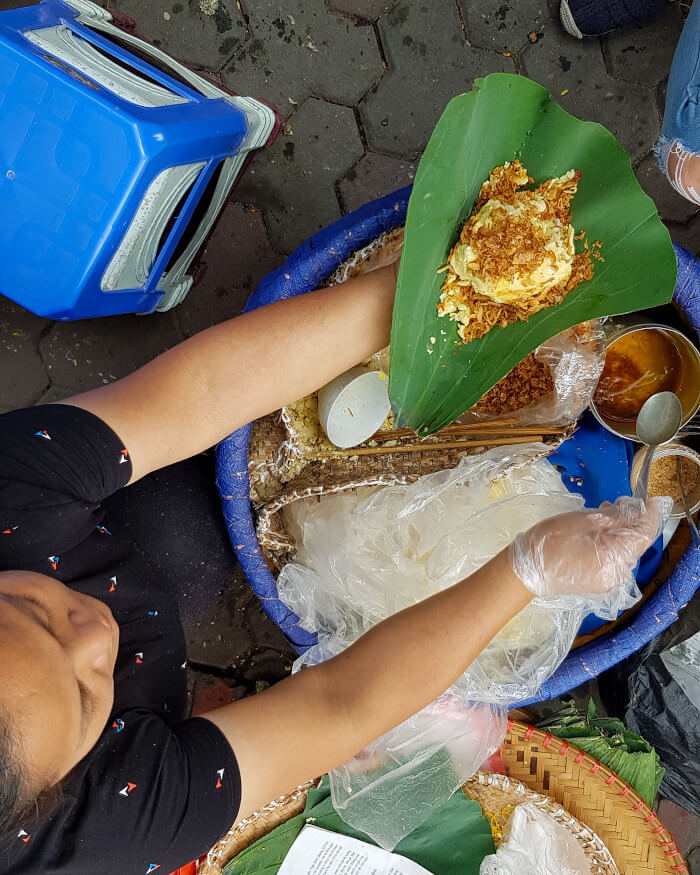
Pic by Jacob from The Travellinghams
Xoi is one of the countless dishes I had never heard of until we visited Vietnam. It ended up being one of our favorite street food dishes in Hanoi. Different regions of Vietnam make different styles, but the best is found in Hanoi.
In Hanoi, it is made from sticky rice cooked with turmeric, mung bean and chicken fat, which gave it a rich savory flavor.
The rice is topped with mung bean paste, pork floss, fried shallots, and a dash of a “secret sauce” that varies from vendor to vendor. As street food, it is only sold in the morning.
You can find it everywhere in the city. Down crowded streets and alleys, old ladies drive by on bicycles with bamboo baskets full of the ingredients.
You can also find it in sit down restaurants, but the absolute best place to have it is at one of the semi-permanent spots where ladies crouch on tiny stools dishing it out to hungry customers who either take it to go or sit on one of the few stools nearby.
It is probably the cheapest meal in Hanoi, costing only 10,000 VND per plate, so it is a very common breakfast for workers in the city.
My family loved it, and our favorite way to start the day was to pick it up from our favorite vendor, then walk to the nearby Hoan kiem lake and have a peaceful picnic. Those mornings will always what I remember when I think of Hanoi.
57. Bai Sach Chrouk in Cambodia
By Jacob from The Travellinghams
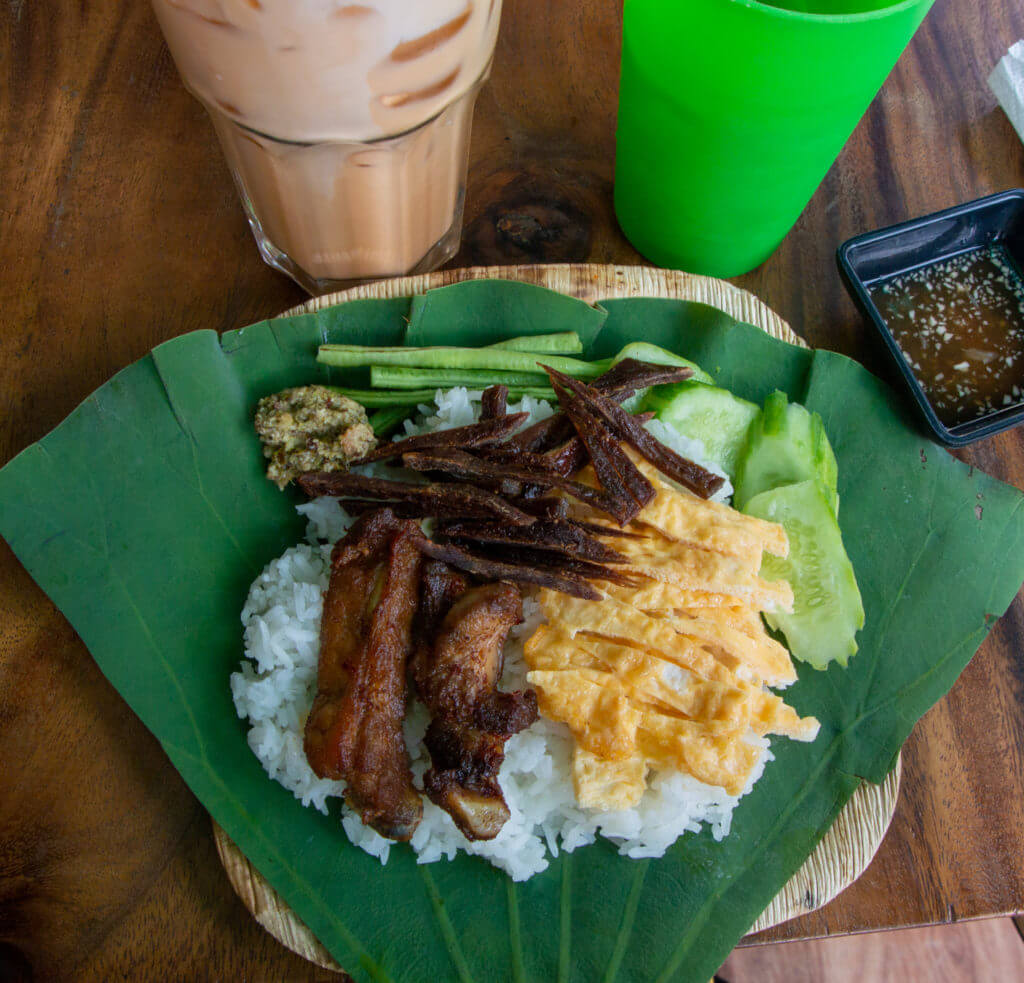
Pic by Jacob from The Travellinghams
Cambodia has an under-appreciated cuisine that is ripe for exploration. Tales of food poisoning and bland food keep most Westerners at touristy places. While food quality in some places can be iffy, the street food in Phnom Penh is top notch.
Breakfast is an important meal in Cambodia, and bai sach chrouk is the most common option around the country. Not every rendition is amazing, but there are plenty of places in Phnom Penh and other cities that make this simple dish to perfection.
The dish consists of rice, grilled pork, an egg and a sauce made from fish sauce and red chilies. Aunties manning roadside shacks and street food stalls, take these simple ideas and turn them into the best breakfast dish in town.
Sit down next to some curious locals who are always confused why a Westerner is eating there and dig in for only 3,000 KHR a plate. Almost every vendor sells iced coffee, so make sure to get some to complete the meal.
58. Num Banh Chok at Touk Mahek in Kampot, Cambodia
By Jacob from The Travellinghams
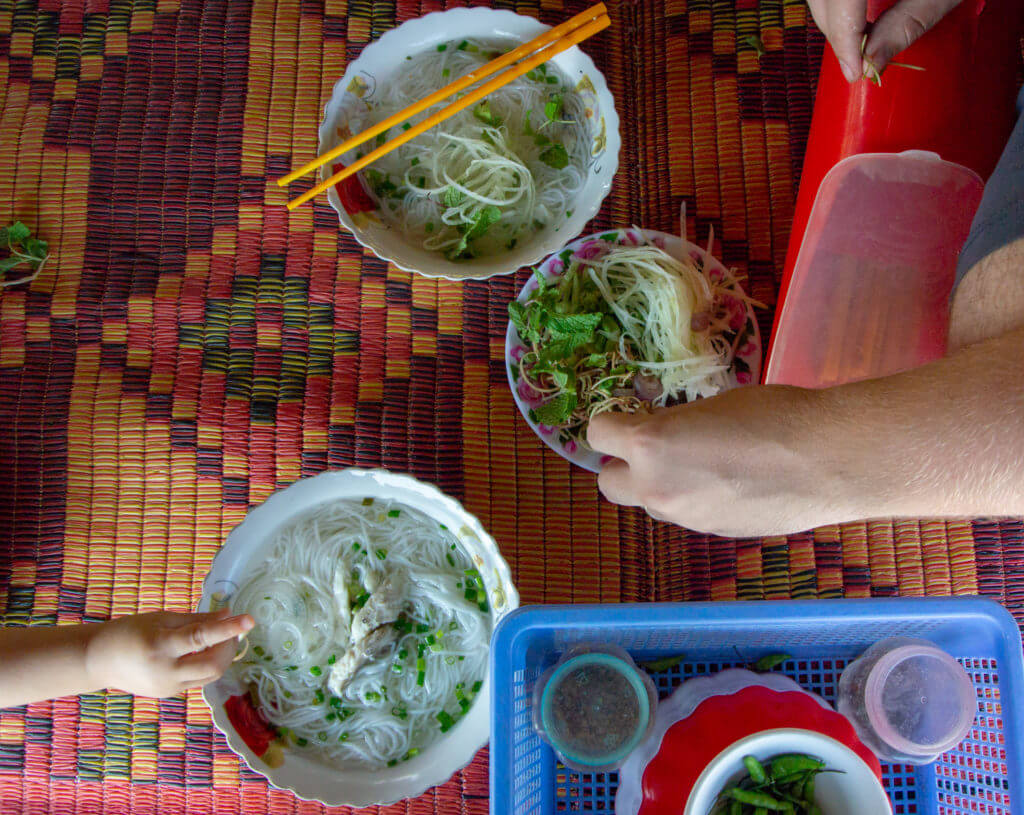
Pic by Jacob from The Travellinghams
Most people who travel to Cambodia end up visiting Kampot, but most of them don’t realize that it is home to one of the best dishes in Cambodia.
Num banh chok is a noodle dish that is common around Cambodia, but this version can only be found in Kampot (and only a handful of places make it).
Compared to other Southeast Asian countries, Cambodian cuisine is not very regional, so the few regional dishes are definitely worth seeking out.
The dish is a light soup made with a fish broth using a fish that only lives in the nearby Touk Mahek river. It is simple and refined and perfectly exemplifies country style Cambodian food.
The shacks that sell this dish are located just outside of town and feel a world away from Kampot. The setting is almost as great as the food itself. A bowl of this delicious dish only costs 2,000 KHR, making it the cheapest thing to eat in the city as well!
59. Gyeran-Ppang (계란빵) Egg Bread in Korea
By Joel of In My Korea
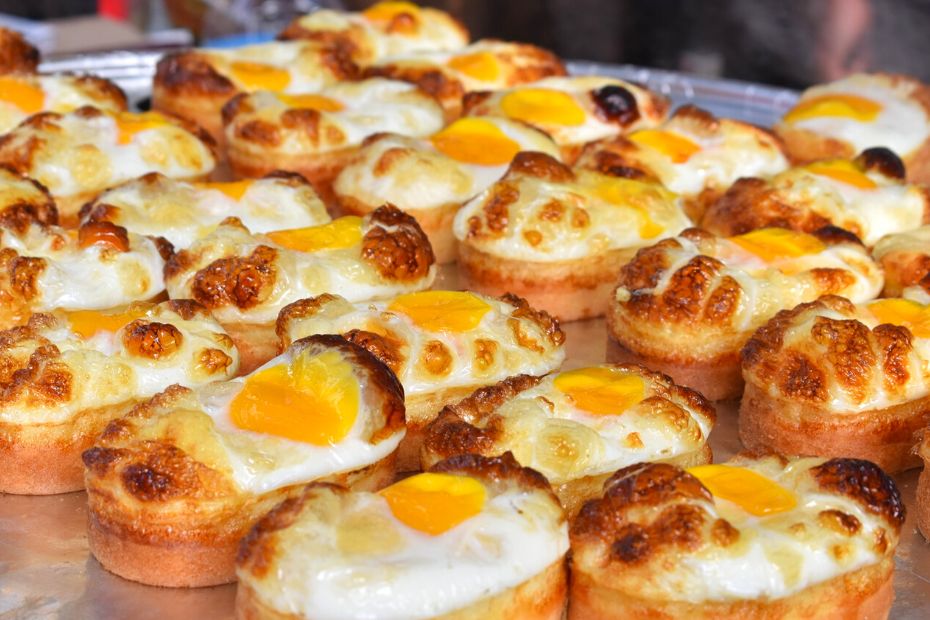
Pic by Joel of In My Korea
A staple of Korean markets and street food stalls across the country, gyeran-ppang is cheap, delicious, and one of the best Korean winter street foods to warm you up.
Gyeran-ppang is a fluffy snack shaped like a tiny loaf of bread with a whole egg dropped on top. It’s baked using special trays that produce the unique oblong-shape. The egg yolk sits on the top like a little yellow beret.
Hot, messy and perfect on a cold day, this street food is a sweet and savory delight. The bread is moist with a typically Korean sweetness to it, but with a texture that is more like a steamed bun.
The main topping is a single egg. Other toppings can include ham, cheese, or parsley. If you’re not keen on spicy dishes, which a lot of Korean street foods are, then this is perfect for you. Salty, sweet, and gooey, it’ll leave you with a smile on your face.
Gyeran-ppang started out as a street food snack at Inha University in 1984. It was sold at the back gate and poor, hungry students would grab one to eat on the way to or from class.
Now, you can see buy these eggy wonders in small tents on street corners anywhere in Korea. They’re most popular during winter, but you can find them any time of year.
Visit Myeongdong Market to find freshly baked gyeran-ppang. They cost about 1,500-2,000 KRW, or just over $1 -$1.50 USD.
Did you like this list of the best Asian street food to eat? What are your favorite street food? What have you not tried yet?
PS. Travel and food bloggers, if you want to add something to this list of top Asian street food, email me at abby@thewingedfork.com
Other Foodie Listicles For Your Reading Pleasure
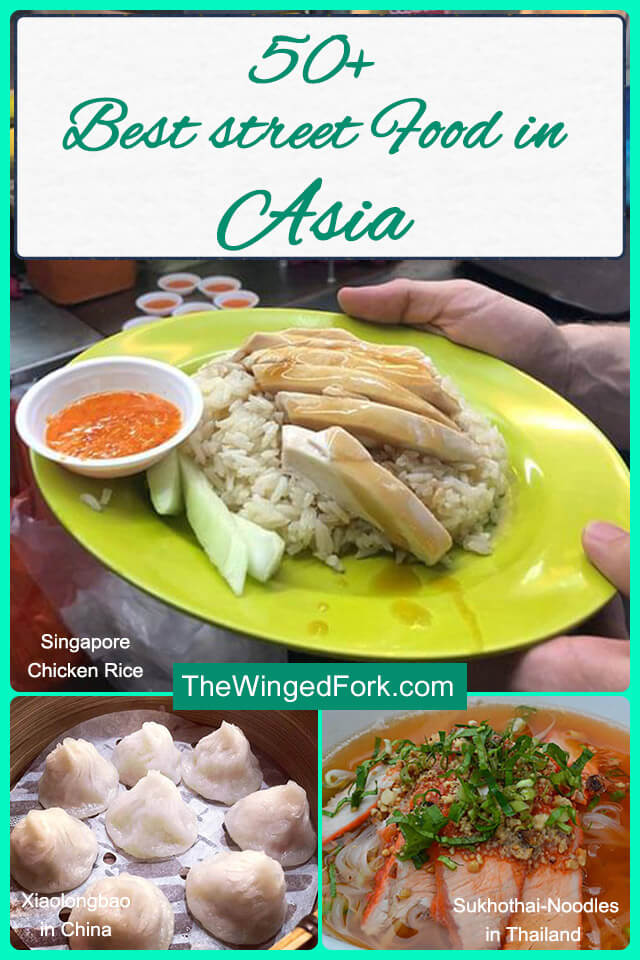
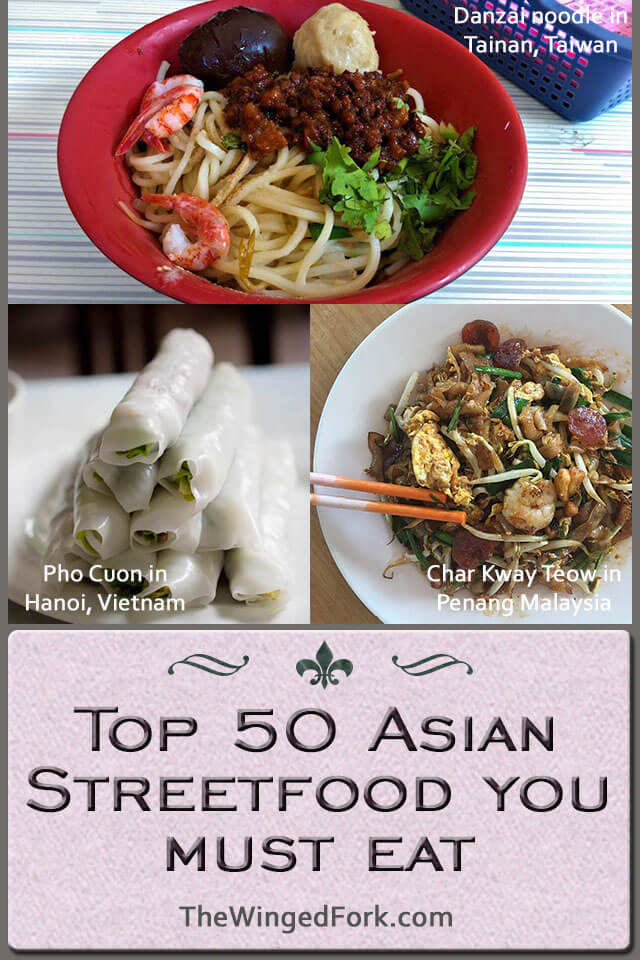
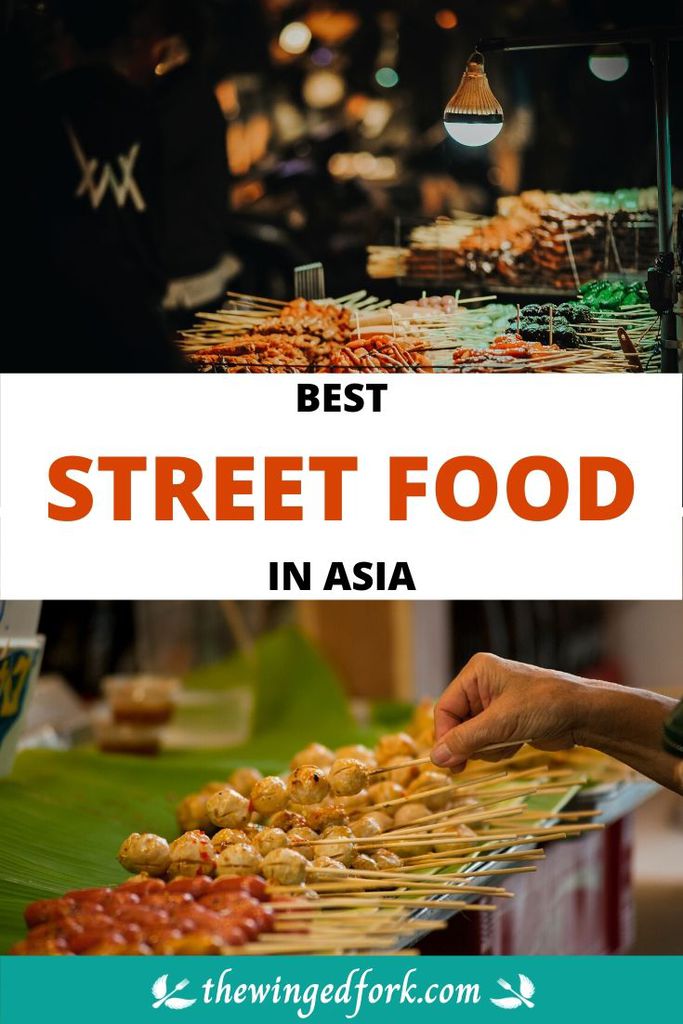
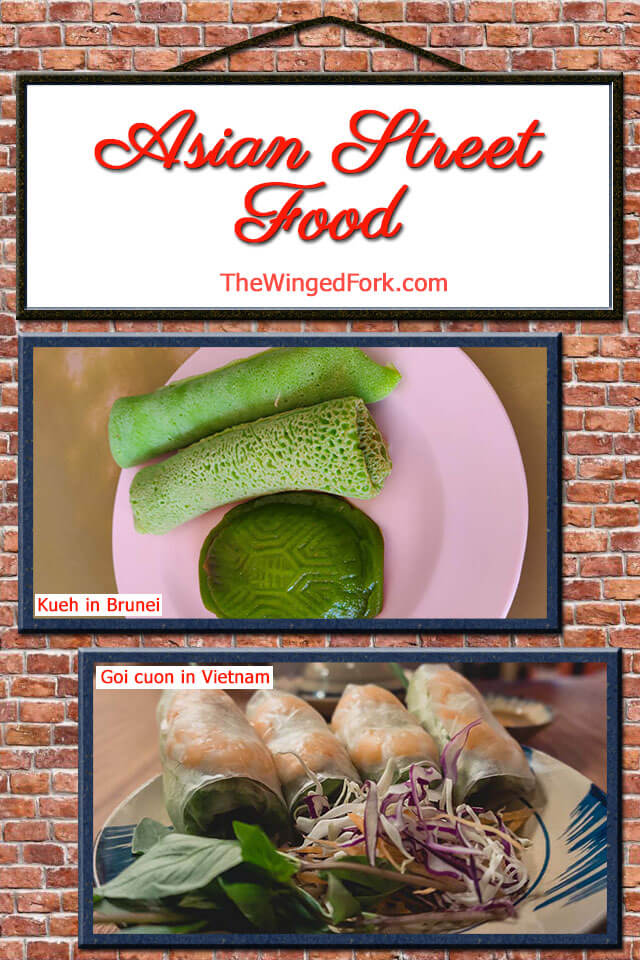
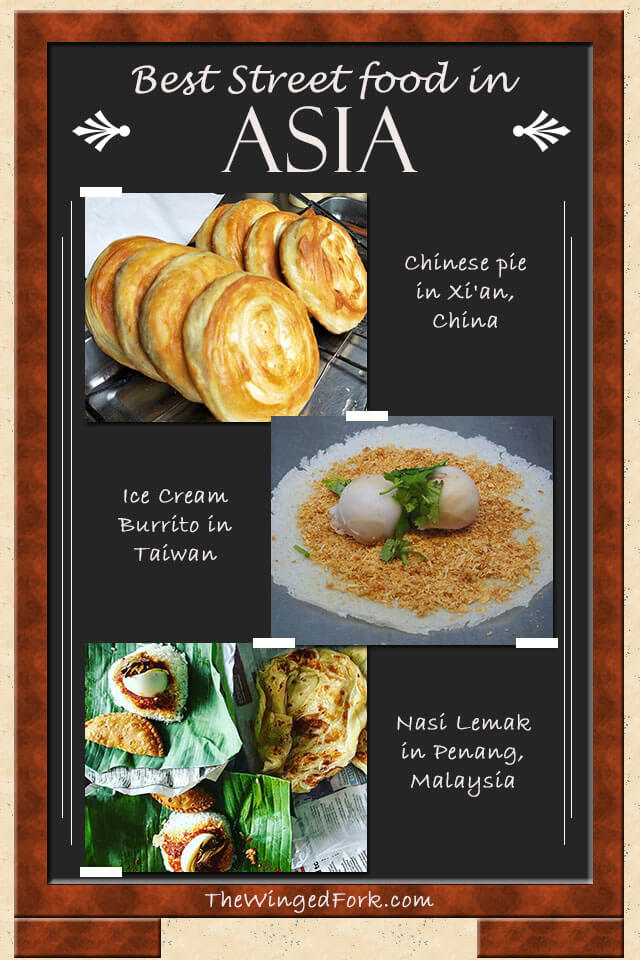
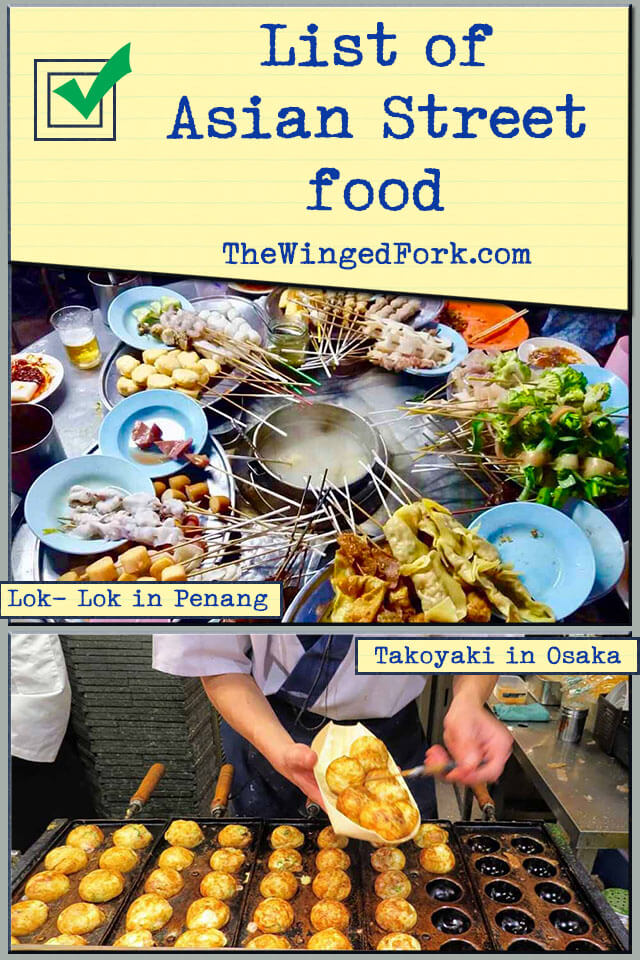
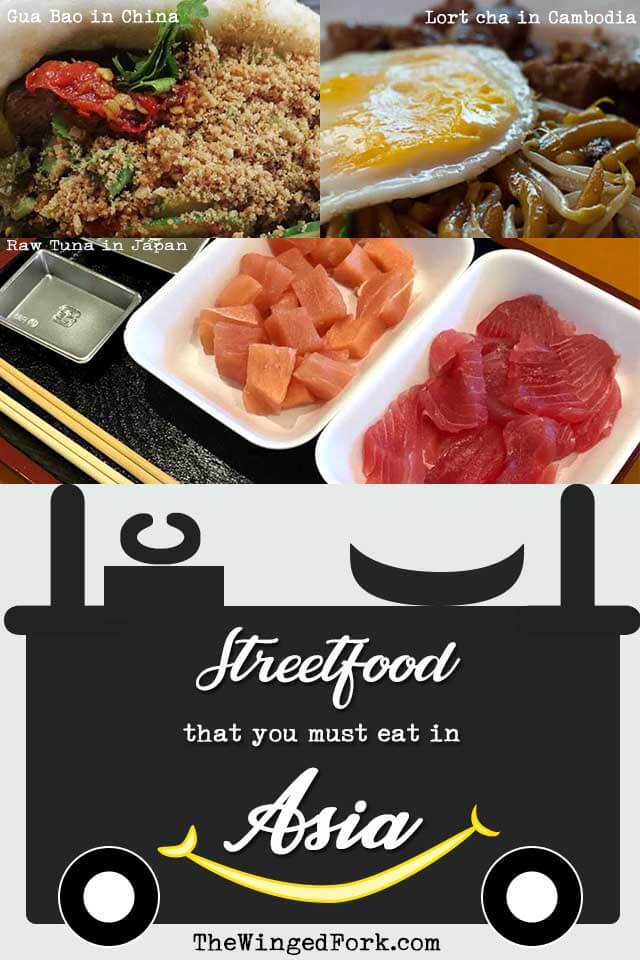
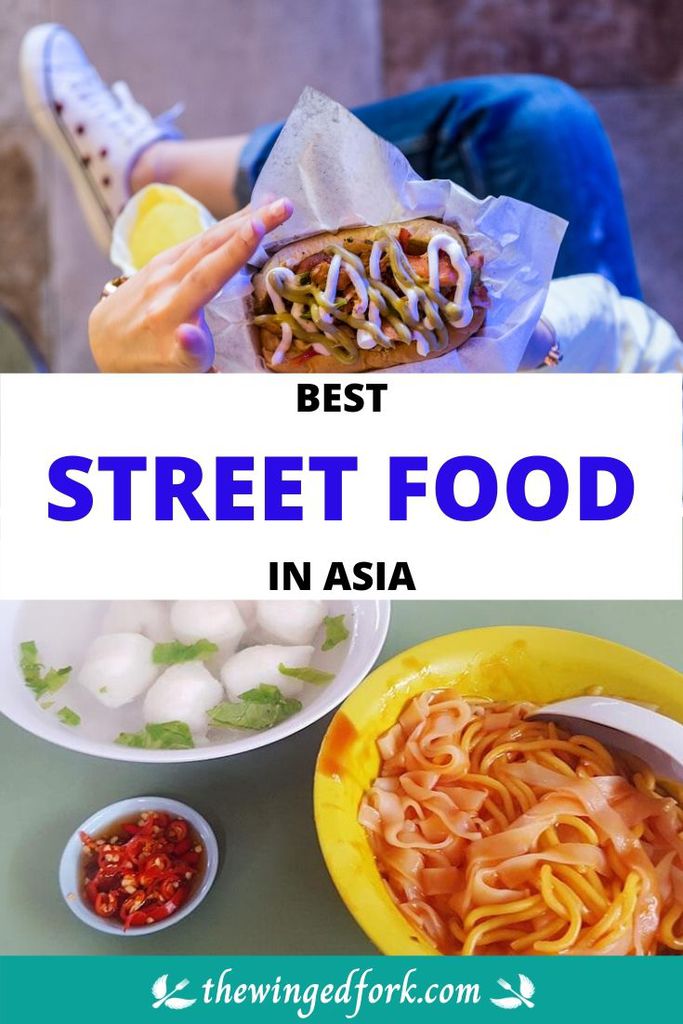
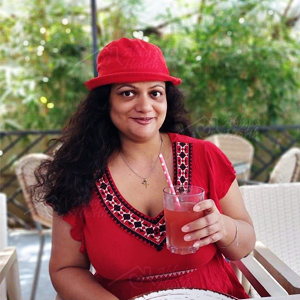
I’m an East Indian foodie and travel blogger from Bombay, India. I’ve travelled across parts of Europe and Asia, and love writing about my experiences with people and cultures. And naturally, I love food, wine, and travel, and have an endless bucket list of places to go to, and experiences I must blog about.
I also love baking and experimenting with food, with a little help from my family. If you must know, my favorite things are nice rainy days, the smell of cakes in the oven, playing in the snow, glasses of wine, and dark chocolate.
More info about me here!
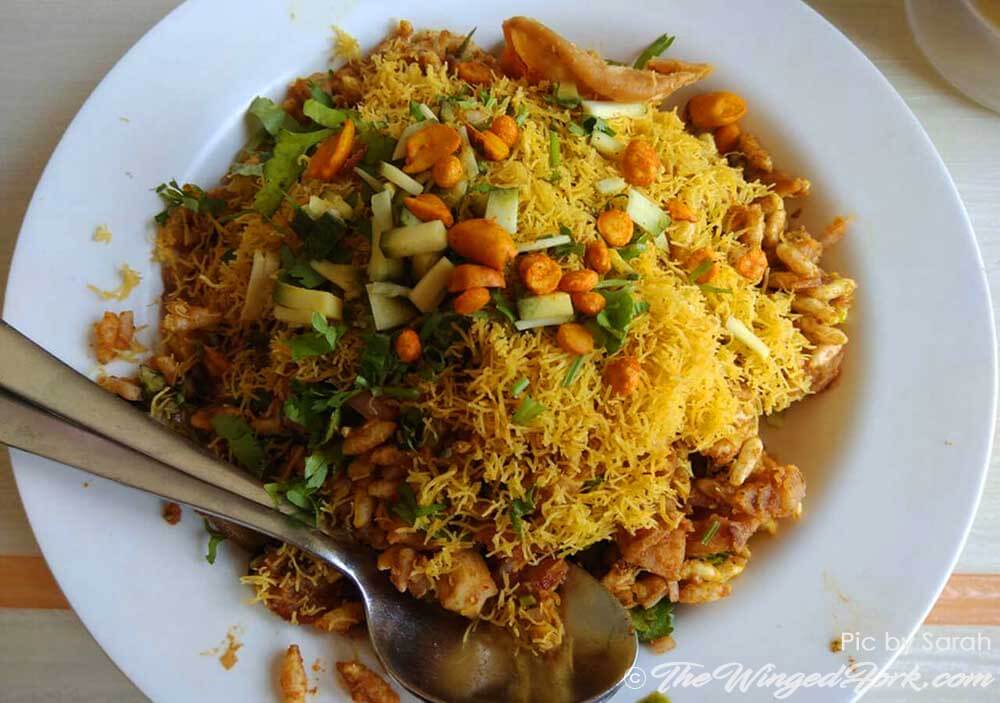
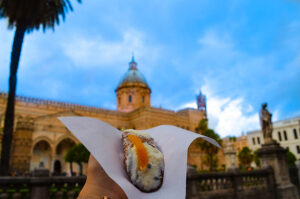
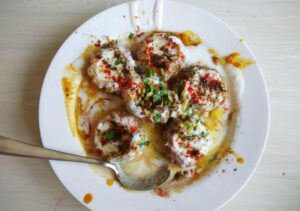

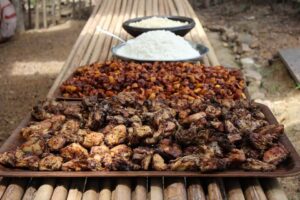

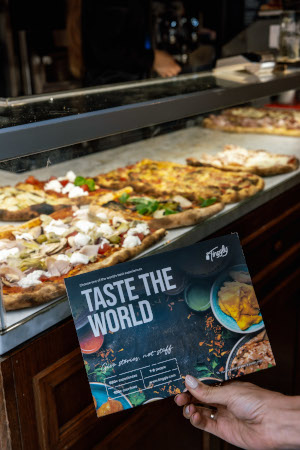
I ate Banh Mi when I travel to Vietnam. There are many kinds of Banh Mi for you to choose. It’s delicious
I believe, that Asia is like another world of food. Their food is so different from European or American food. I hope that I will manage to try real Asian food someday.
This is such an awesome list of the best Asian street food. I have tried quite a few among these and my favorite is definitely the sticky rice in bamboo from Cambodia. This streetside snack was heavenly. Looking forward to more such delicious posts from you.
I’m drooling and dreaming of all the places I want to go!
Me too! So many foods added to the must-try list! 🙂